OVER-THE-RHINE

Treatment Guide
Amanda Schmidt, LME

“Sunscreen, sunscreen, sunscreen! Wearing a daily facial sunscreen is the most important thing for your skin’s health. The sun is the number one cause of premature aging, wrinkles, fine lines, brown spots, and skin cancer. I recommend a broad spectrum sunscreen with an SPF above 30. Broad spectrum sunscreens are pretty much the standard in sunscreens now but double check that yours says so. This type of sunscreen protects against both UVB and UVA rays, which penetrate deeper and cause long term sun damage. The wonderful thing about facial sunscreens now is they are not thick and greasy feeling, so you don’t have to worry about them causing any breakouts or feeling like you have too much on your face. My favorite sunscreen has a slight tint to it so I can just throw it on and still feel like I have some coverage without wearing makeup.”
Chloe Hegge, RN, BSN

“It’s never too early to start a retinoid! Retinoids help with cell turn over which helps keep the skin looking young. Some benefits include helping to treat active acne as well as help with acne scarring, improving discoloration, as well as overall texture of the skin. I suggest starting with a pea sized amount two to three times weekly and increasing to nightly as tolerated. If your skin seems irritated, try mixing with a moisturizer to help decrease the irritation. Starting a retinol is not a sprint, it’s a marathon so be patient and keep pushing through the ‘retinol blues,’ you won’t regret it!”
Kylee Finn, RN, BSN
“Anyone can benefit from adding antioxidants into their skin care routine. Antioxidants are an umbrella term for different vitamins such as vitamin C, Vitamin E, Niacinamide, and more. Antioxidants have many benefits to your skin, but the main benefits are to keep your skin cells healthy by helping repair damage from the sun, preventing cellular damage and calming inflammation. When your skin cells are functioning properly your skin cell cycle can run smoothly, making it easier to produce collagen and elastin. By simply adding this topical into your skin care routine you can correct signs of aging, prevent sun damage, and overall brighten your skin!”

Treatments
HydroJelly Mask
These next-generation peel-off masks are made primarily from seaweed and kelp algae combined with the latest in electrolyte technology. Each of the potent electrolyte formulations balance skin to combat dryness, fatigue and irritation.
Treat: Dryness, Skin Fatigue, Irritation
Benefits: Gentle & soothing, Immediate results, Free from parabens, sulfates, phthalates, and talc
Microneedling

Diamond Glow
Diamond Glow exfoliates, extracts, and infuses customized serums all at the same time to plump skin by up to 70%. This no-downtime treatment is appropriate for all skin types.
Choose from 5 targeted treatments including: Anti-Aging TNS Advanced+, Hydrating HA5 Hyaluronic Acid, Skin Brightening, Vitamin C Antioxidant, Pore Clarifying
Treat: Dull Skin, Acne, Complexion, Dry Skin, Fine Lines & Wrinkles
Oxygen Facial
Whether you have rosacea, sensitive skin, or just want to look refreshed before an important event, the Intraceuticals Oxygen Facial is a great choice. It is like giving your skin a big drink of water.

Treat: Dry Skin, Redness, Rosacea
Benefits: Relaxing, No downtime, Great for sensitive or rosacea-prone skin
Chemical Peels
Chemical peels range from gentler treatments that will refresh your skin and cause no peeling at all to deeper peels that will improve more advanced concerns. Your provider will help choose the treatment that is right for you.
Treat: Texture, Sun Damage, Fine Lines, Acne Scarring, Brown Spots
Benefits: Can treat all skin types, Great for skin maintenance and aging prevention
Glacial Rx Gloss
Glacial Rx is the first and only facial treatment that uses precision cooling to treat redness, melasma, and brown spots. Fight inflammation, exfoliate skin, and normalize melanin with this relaxing and soothing facial that helps to brighten your skin.
Treat: Redness, Melasma, Brown Spots
Benefits: Minimal to no downtime, Fight disorders of inflammation, Cooling and soothing treatment
Microneedling, also known as collagen induction therapy (CIT), rejuvenates skin, treats fine lines and wrinkles, and improves acne, scars, and stretch marks.
Treat: Fine Lines, Wrinkles, Scarring
Benefits: Stimulate collagen & elastin production, Minimal downtime, Great for skin maintenance
Dermaplaning
Dermaplaning is a very popular no-downtime procedure in which your provider gently exfoliates your skin to reveal a smooth texture.
Treat: Dull skin, dead skin
Benefits: Enhances other procedures such as peels or facials, Improves absorption of skincare products, Makeup will apply more smoothly
LED Light Therapy
Use the power of blue LED light to treat acne by regulating oil production in the sebaceous glands and kill acne-causing bacteria.
Treat: Acne
Benefits: Painless with no downtime, Safe for all skin colors and types, Can be added on to other treatments
















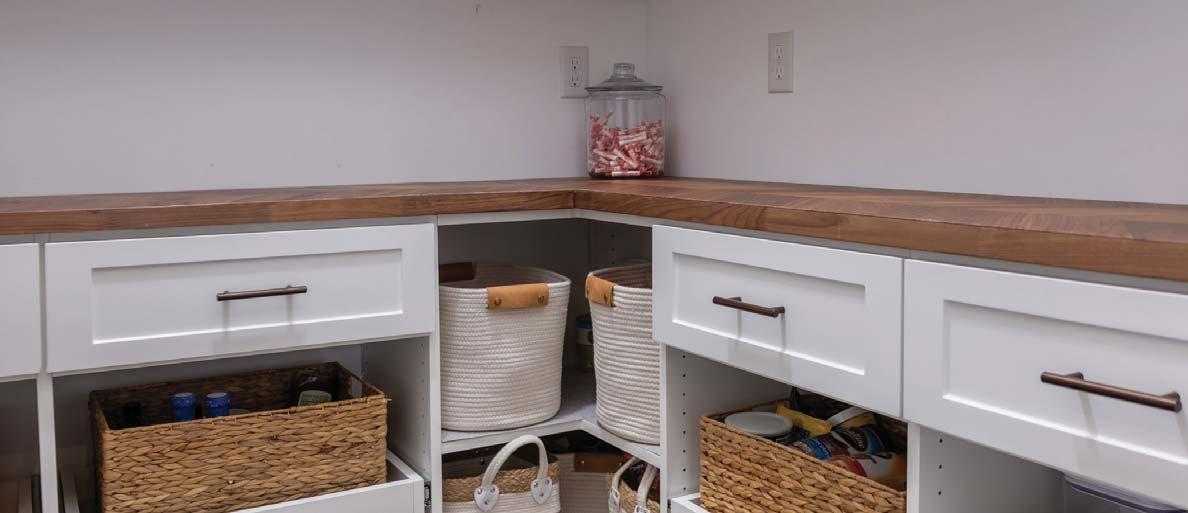




P.

32

OVER-THE-RHINE TURNS A CORNER
BROOKE BARGANIER SEES WITH HER EYES AND UNDERSTANDS WITH HER HEART P. 48
The pediatric nurse focuses on giving—to family, friends, and patients— despite a lifetime of struggle.
BY CARRIE BLACKMORE SMITH

 FANTASTIC BOTANICAL BEASTS AND WHERE TO BUILD THEM P. 52
FANTASTIC BOTANICAL BEASTS AND WHERE TO BUILD THEM P. 52
At Applied Imagination in Northern Kentucky, the creative brains behind Krohn Conservatory’s popular holiday show, the whimsy is a family affair.
NOVEMBER 2023 CINCINNATIMAGAZINE.COM 5





















14 / CONTRIBUTORS
14 / LETTER FROM THE EDITOR
FRONTLINES
17 / DISPATCH
Jeff Tweedy and the songs he knows by heart
18 / SPEAK EASY
Becca Malech illuminates classical (and pop) music
18 / ELECTIONS
What’s on the ballot in Cincinnati?
20 / STYLE COUNSEL
Tim Rosewood’s got swag
22 / GREAT ROOM
A colorful Clifton kitchen
24 / STOREFRONT
Badges Drum Shop, Mason
26 / DR. KNOW
Your QC questions answered
COLUMNS
28 / WELCOME TO MIDDLEHOOD
My outdoor cat taught me about parenting
BY JUDI KETTELER
88 / CINCY OBSCURA
An archbishop’s sweet ride
BY LAUREN FISHER
DINE
70 / OFF THE MENU
A new wave of Filipino restaurants

74 / HOT PLATE
Rusk Kitchen + Bar, East Walnut Hills
74 / TABLESIDE WITH…
Mansa Malik, Matunda Juicery
76 / TRY THIS
Hawkers Alley’s Tornado Potato Fries
79 / DINING GUIDE
Greater Cincinnati restaurants: A selective list
ON THE COVER photograph courtesy THE OHIO HISTORY CONNECTION
photograph by WES BATTOCLETTE retouching by BRITTANY DEXTER
An extra serving of our outstanding dining coverage.
CITY NEWS
Decoding our civic DNA, from history to politics to personalities. HOME + LIFE

Tracking what’s new in local real estate, artisans, and storefronts.
Insight and analysis on the Bengals and FC Cincinnati.

















End of Year Plans? Consider A Financial Check Up
As a Cincinnati-based team with 55+ years of combined experience, we help everyone from executives and business owners to retirees and families navigate virtually every step of their financial future.

Experience That Can Transcend Generations
Cincinnati Values, Global Experience: Rooted in integrity, hard work, and service, we bring local values, seasoned insights, and world-class resources to your financial life.


Bespoke Strategies, Unique Goals: Off-the-shelf solutions can't paint your unique financial picture. Our tailored strategies help you unlock your vision for the future.
Family-Centered Financial Legacies: Families are the heart of our practice. We are committed to protecting your family's well-being, and nurturing dreams across generations.
OUR TEAM
John Gould:Senior Vice President. Financial Advisor. Certified Financial Planner®. Senior Portfolio Manager. Chartered Portfolio Manager®. Certified Private Wealth Advisor®. Certified Exit Planning Advisor®. Workplace Advisor - Equity Compensation. Alternative Investments Director. 27+ years of experience. Anna Kohlem: Assistant Vice President. Wealth Management Associate. Financial Planning Specialist. Complex CSA Coach. 25+ years of experience. Janie Shaffer: Business Development Director. Duke University graduate. Former attorney. 5+ years of experience.
BONUS FOR SUBSCRIBERS
MONTGOMERY
Montgomery Official
Community & Business Guide
Discover what’s new and notable about Montgomery, including where to eat, shop, and play.

COMING NEXT ISSUE
Morgan Stanley and its Financial Advisors do not provide tax or legal advice. Individuals should seek advice based on their particular circumstances from an independent tax advisor. CFP Board owns the marks CFP®, CERTIFIED FINANCIAL PLANNER™, and CFP® (with plaque design) in the U.S. Morgan Stanley Smith Barney LLC offers insurance products in conjunction with its licensed insurance agency affiliates. Morgan Stanley Smith Barney LLC. Member SIPC. CRC 5910877 09/2023


Faces of Cincinnati
Meet the people behind some of our region’s most successful businesses and organizations.




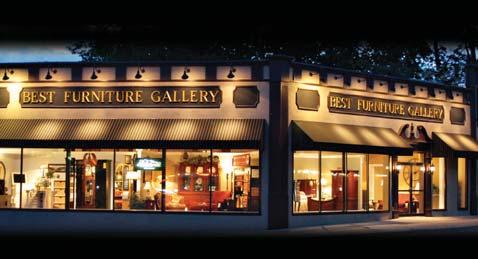

IMAGINEAWORLD WHEREYOUR MENTALHEALTHIS YOURTOP PRIORITY.
AtLindnerCenterof HOPE,webringthat worldtolife.Forovera decade,ourexpertstaff hashelpedthousands overcome anxiety, depression,and addiction.Nomatter yourageorstruggle, LindnerCenterofHOPE offerstransformative servicesdesignedto promotelong-lasting healing.Youdon'thave tofacementalillness alone.
Jointhecountlessothers who'vefound Lindner CenterofHOPE.
EDITOR-IN-CHIEF John Fox

DESIGN DIRECTOR Brittany Dexter
DIRECTOR OF EDITORIAL OPERATIONS
Amanda Boyd Walters
SENIOR EDITOR
Aiesha D. Little
ASSOCIATE EDITOR Lauren Fisher
SOCIAL MEDIA MANAGER Kane Mitten
CONTRIBUTING EDITORS Jim DeBrosse, Kathleen Doane, Jay Gilbert, Lisa Murtha, Laurie Pike, Kevin Schultz, John Stowell, Linda Vaccariello, Jenny Wohlfarth, J. Kevin Wolfe
EDITORIAL INTERN Rebekah Bostick
DIGITAL INTERN Braden White
SENIOR ART DIRECTORS Jen Kawanari, Emi Villavicencio
ASSISTANT ART DIRECTORS Carlie Burton, Jessica Dunham
ADVERTISING DESIGNER Sophie Kallis
CONTRIBUTING ARTISTS Lance Adkins, Wes Battoclette, Aaron M. Conway, Chris Danger, Andrew Doench, Devyn Glista, HATSUE, Chris von Holle, Danielle Johnson, Jeremy Kramer, Ryan Kurtz, Lars Leetaru, Marlene Rounds, Dola Sun, Catherine Viox
PRODUCTION DIRECTOR & IT SYSTEMS ADMINISTRATOR

Vu Luong
PUBLISHED BY CINCINNATI MEDIA, LLC
CEO Stefan Wanczyk
PRESIDENT John Balardo
PUBLISHER Ivy Bayer
SENIOR ACCOUNT MANAGERS
Maggie Wint Goecke, Joe Hoffecker, Julie Poyer

SENIOR MANAGER, SPONSORSHIP SALES
Chris Ohmer
SENIOR OUTSIDE ACCOUNT REPRESENTATIVE
Laura Bowling
SPECIAL PROJECTS MANAGER
Cecilia Rose
EVENT COORDINATOR
Whitney Gordon
BUSINESS
OPERATIONS DIRECTOR Missy Beiting
BUSINESS COORDINATOR Erica Birkle
CIRCULATION
AUDIENCE DEVELOPMENT DIRECTOR Geralyn Wilson
CIRCULATION MANAGER Riley Meyers
EDITORIAL/ADVERTISING OFFICES
1818 Race St., Suite 301 Cincinnati, OH 45202 (513) 421-4300

E-MAIL cmletters@cincinnatimagazine.com

WEB cincinnatimagazine.com
SUBSCRIPTIONS
1-866-660-6247
E-MAIL Cincinnati_Service@hourmediagroup.com
513-536-HOPE
VISIT
CALL LindnerCenterofHope.org

Planned Parenthood Southwest Ohio provides reproductive care and education services throughout 23 counties in southwest Ohio and northern Kentucky. Our services include:
• pregnancy testing
• STIs testing therapy
• birth control services and relationship education
OVER-THE-RHINE IS LIKE ONE OF THOSE CURVY FUNHOUSE MIRRORS YOU ENcounter at a fair or on the boardwalk. With every different angle you look at it, a distorted image reflects a huge head or squished down legs. Move a few inches, and you see an entirely different you.
Cincinnati’s most iconic neighborhood looks different to just about everyone (see “Over-the-Rhine Turns a Corner,” page 32). It’s home, and maybe has been for decades and generations. It’s where you grew up, but you got out as soon as you could. It’s where you attend the symphony or the opera or a play. It’s where wealthy developers are pushing out poor people.
It’s our own French Quarter, a historic residential neighborhood that stars in tourism campaigns. It’s a Disney-fied caricature of itself, with its authenticity being replaced by sanitized culture. Most of the public monuments—Music Hall, Memorial Hall, schools, parks, Findlay Market—have been renovated and upgraded for future generations. Its only true grocery store was closed and moved across Central Parkway.
Two memorable experiences of mine with Over-the-Rhine are similarly juxtaposed. During the unrest in 2001, I had a media pass to follow Cincinnati Police officers on patrol. One afternoon they formed a line along the south lanes of Central Parkway and faced OTR. It was eerily quiet. Teenage boys stood at the chain link fence at Vine Street and Central Parkway, where the Gateway garage is now, and stared back. The city’s message was clear: Do what you want for now in Over-the-Rhine, but don’t bring that downtown.
Eleven years later, I was at Washington Park’s reopening on a scorching July morning. As the fountains were turned on for the first time, a mounted police officer stopped his horse to have a drink, and a bunch of neighborhood kids gathered around to pet its head. A group of protesters put down their “Parks for everyone!” signs and cooled off in the water. Maybe, I thought, everyone can get along.
Both of those memories and all of the opinions expressed above—and many more—coexist in Over-the-Rhine. That’s why it’s a special place for each of us... and all of us.
JOHN FOX EDITOR-IN-CHIEF

DEBORA ISLAS



When Brazilian illustrator Debora Islas isn’t working, you will find her relaxing at home or taking nature getaways, which help her find inspiration. “My portrait of Brooke Barganier combines three things that make me very excited,” Islas says of her illustration for “Brooke Bargainer Sees with Her Eyes and Understands with Her Heart” (page 48). “An inspirational story, the female figure, and the possibility of including playful elements and nature in the composition.”
PATRICK MURPHY


When it comes to playing drums, contributing writer Patrick Murphy knows his stuff: You can find him playing in two local bands, Lost Henry and Bug Juice. This month, Murphy visits Badges Drum Shop in Mason (“The Beat Goes On,” page 24), a must-see for any drum player. “There’s an incredible amount of passion in this store,” he says. “You feel it when you walk in. I hope people go back several times to see everything they offer.”
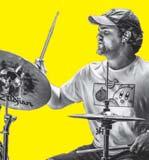
RYAN KURTZ
Over-the-Rhine isn’t a new hotspot for Ryan Kurtz—up until 2016, the freelance photographer called the neighborhood home base for his studio. He’s since set up shop in Northside, but recently revisited his old stomping grounds for “Overthe-Rhine Turns a Corner” (page 32). “OTR has gone through drastic transitions in that time,” Kurtz says. “And I had doubted it would ever become what it is today. It’s truly a special place in Cincinnati—and in the Midwest, for that matter.”
When a loved one is in the ICU, their care can be complex, requiring a team of medical professionals—and an experienced, world-class leader to coordinate the effort. UC Physicians intensivists provide just such expertise. From training the next generation of doctors at the bedside to participating in important clinical trials and prestigious international conferences, these physicians ensure that the sickest of the sick receive the most advanced—and integrated—treatment possible. It’s comprehensive care for the critically ill. And it’s Indispensable medicine,




med.uc.edu/indispensable


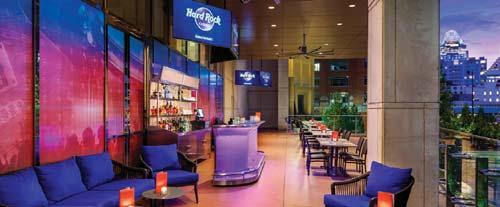







THE POWER OF MUSIC
EVER THINK YOU’D HEAR AN ACOUSTIC VERSION OF “SMOKE ON THE WATER” AT Joseph-Beth Booksellers? Well, you’re still not going to when Wilco frontman Jeff Tweedy comes to town with his new book, World Within a Song: Music That Changed My Life and Life That Changed My Music.

For one thing, the November 9 appearance will feature Tweedy in conversation with Louisville guitarist and music archivist Nathan Salsburg in the Walnut Hills High School auditorium, not the store. For another, “I usually don’t do a whole lot of playing and singing at the book events,” says Tweedy.
But the Deep Purple anthem’s timeless riff was the first one a pre-adolescent Jeff Tweedy learned to play on the guitar, and therefore the first chapter in the book. “This, my friends, was the ‘Seven Nation Army’ of my day,” he writes. “Who cares if it took a riff so demeaning and dumb to instill a little belief in myself as a potential musician. We all start somewhere.”
World Within a Song is not a book of criticism, but rather a quasi-memoir told through 50 songs. Not necessarily Tweedy’s 50 favorite songs (as that first chapter already suggests), but 50 songs that mean something to him, by artists ranging from Otis Redding, The Knack, and Grandmaster Flash to Television, Rosalía, and the Staples Singers. “I just think it’s an endlessly entertaining topic, obviously, because we get so wrapped up in songs,” says Tweedy. “We’re so entwined in the music we listen to. It has a powerful effect on how we see ourselves and how we think about the world. Writing songs is my effort to participate in that type of feeling.”
Tweedy writes that if he could do it all over again, he’d
CONTINUED ON P. 18
Jeff Tweedy tells his life’s story through 50 songs that truly made a difference. JASON COHEN
DISPATCH
probably have penned this book before his more traditional autobiography, Let’s Go (So We Can Get Back), published in 2018. That was followed by How to Write One Song in 2020, which was more about his own creative process.
For Tweedy, other people’s songs are a box full of, no, not letters, but moments in a life. Where were you when you first heard a song? What were you doing? Who did you hear it with? How were you feeling at the time? As a musician, songwriter, and bandleader, Tweedy is an artist, entertainer, and perhaps even a rabbi, but above all he’s a bringer of joy and community. “Creating connection through music is my life’s work,” he writes.
Bachman Turner Overdrive’s “Takin’ Care of Business,” and his attempt to get his mom to understand his tortured teenage feelings by playing her “Balancing Act” by the Boston post-punk band Volcano Suns. Tweedy’s generational and musical peers—yes, I’m one of them—will be further delighted by the inclusion of such indie and college radio legends as The Minutemen, Slovenly, and The Replacements.
Reading the book feels more like listening to Tweedy talk than listening to a Tweedy song; he’s an extremely conversational prose writer who tends to read his own work aloud to himself.
Talking Music
Jeff Tweedy is “in conversation” at 7 p.m. November 9 at Walnut Hills High School. Tickets include a copy of his new book. josephbeth.com
The book’s song chapters are interspersed with what Tweedy calls “Rememories”— something he started doing on his Substack, Starship Casual, where you’ll also sometimes find him posting acoustic versions of other people’s songs. They’re anecdotal flashbacks, both musical and not, from both his childhood and his band days, including in his first group, Uncle Tupelo.
Really, though, the entire book is “Rememories.” A remembrance of childhood friendship connected to Michelle Shocked’s “Anchorage” is particularly heart-tugging. He also writes about his father’s love of Leo Sayer’s “Long Tall Glasses,” how he originally thought his guitar-playing cousin BeBo actually wrote
ELECTIONS
ILLUMINATING THE MUSIC EXPERIENCE
“That’s the only way I can tell if it’s sounding like me and if I’m getting the tone,” he says. “That it’s not dictatorial or didactic or overly opinionated.”
Like we’re all sitting around listening to records, because we’re all connected through our favorite bands and records.
“Music is just the thing I most relate to the world through,” he says. “In a profound and real way, I’m connected to the world through other people’s songs.”
And who knows? Given that there’s a default “request song” form for the Cincinnati event on the tour dates portion of Wilco’s website, you still might get to hear a bit of music. Maybe something from the band’s new album, Cousin. “I don’t know,” says Tweedy. “I could probably play ‘Smoke on the Water’ on the acoustic guitar. There’s nothing stopping me.”
DECISION DAY
Cincinnati residents vote November 7 to keep the only interstate railroad owned by a U.S. city, or sell to Norfolk Southern for $1.6 billion. All nine City Council positions are up for grabs as well. And everyone in Ohio votes on major abortion and marijuana issues.

votehamiltoncountyohio.gov


A deep love for classical music was rooted in Becca Malech’s upbringing in California. “My grandmother and I would listen to classical music together,” she says. “It became the backdrop of my life.” She now creates musical memories for a wider audience as associate producer for Candlelight Concerts, which feature a string quartet playing themed music shows surrounded by hundreds of batterypowered candles. This month’s shows include Pink Floyd (Woodward Theater), Bach to The Beatles (Rhinegeist), Queen (Rhinegeist), and ABBA (Memorial Hall).
What is a typical Candlelight concert like? While classical music is a significant part of our repertoire, we’ve expanded to feature tributes to iconic artists like Queen, ABBA, and Taylor Swift performed by talented string quartets. We aim to strike a balance between classic compositions and more contemporary pieces to cater to a broad audience.
How does the ambiance of candlelight contribute to the overall experience? It’s about creating a magical atmosphere. We wanted to take classical music out of traditional concert
halls and into distinctive spaces with rich cultural backgrounds and architectural significance. The addition of candles intensifies the emotional experience.
Candlelight likes to engage local talent for its shows. Why is that important? Every city has its own unique artistic community, and we want to provide a platform for local musicians and artists to shine. We use various methods to discover talent in Cincinnati, but one of our primary tools is Instagram. We’re fortunate to collaborate with an exceptional quartet there, String Source, and we work closely with the Listeso boutique artist agency to help us establish other connections in Cincinnati.
How did your passion for classical music lead you to Candlelight?
When I moved to Chicago in 2021, I had the opportunity to work with Candlelight and was instantly captivated by the company’s mission to make classical music more accessible. I love making it feel magical and special for those who might not have considered it before.












Tim Rosewood
OCCUPATION: WLWT producer and freelance photographer
STYLE: Streetwear, remixed

How would you describe your style? Being comfortable but also being able to express different colors or feelings, or matching the moods of what’s going on in the day. I normally like to match my style based on either the weather or how I’m feeling. Sometimes I like to mix a little streetwear with a little more casual or a little more dapper. I’m a mixed bag. I don’t want to stick with one style. Has style always been important to you? I feel like it kind of hit me in high school. I used to dance in high school. I would watch all these videos, and I noticed some of the things that the people who lived in [New York and California] were wearing. That’s when I was like, This is kind of cool. I tell people I like to dress for myself and to wear what I like. What benefits do you get out of that philosophy? It’s self-confidence. If I’m wearing clothes that I deem to be really nice, it makes me feel like, OK, I can step out in this world feeling good today What’s your favorite thing in your closet? I have a one-of-one jacket made by a friend from college. He started a clothing line, and he did a fashion show for it and asked me to be one of the models. He made this Levi denim jacket that’s split tone—regular blue denim on the left, and then it’s an orange tie-dye on the right side of the jacket, and then on the back, it says, “I like myself” written three times. I also love anime and Japanese culture. I get influenced by that. [The shirt I’m wearing now] has one of my favorite characters from YuYu Hakusho named Yusuke, and the brand made this bedazzled version of it. So it’s all outlined, and I thought it was super dope that they were able to blend streetwear elements into this anime show from the ’90s and make it modern and make it poppin’.
—JACLYN YOUHANA GARVER


Reusch is a big fan of using window treatments for an extra pop of color and pattern. This Roman shade from Ferrick Mason Fabric features the pattern “Cacao Shale
CURVE LOVE
To balance out the unusual lines of those tri-colored Rookwood tiles, Reusch and her team incorporated subtle curves when customdesigning the larger cabinet doors.

IT’S IN THE DETAILS
Even the tiniest design elements tie together in this kitchen. Both the walnut island and the range hood feature brass elements that were custom fit on-site.
SOLE SURVIVORS
Only one original feature remains. “The client loved her existing pendant island lights,” says Reusch. Fortunately for the homeowner, the pendants were just the finishing touch the project needed.
ANEY REUSCH IS NO STRANGER TO grade rooms into bold, colorful living spaces. So when clients brought her in on the renovation of their 1920s Clifton she was all in. Walls came down, doors were moved, and the all-white oor-to-ceiling
pliances, and a walnut island with room wood tile backsplash inspiration image in a magazine,” says Reusch, founder


ticulous planning—contractors followed a color-coded map to get the install just right—but the backsplash ended up being a total scene-stealer. If you think a kitchen like this is too pretty to cook in, think again. Reusch also worked in practical, creative storage solutions like the handy appliance garage cabinet and a special nook in the island that’s perfect for stowing away cookbooks.

THE BEAT GOES ON
—PATRICK MURPHYAsk any drummer this question and you’ll get plenty of odd-ball answers: What does it mean to play in the pocket? Are you a little behind the beat, a little ahead, or dead on? No matter what any particular drummer’s answer is, the meaning will be the same: You’re playing damn well.
It’s no stretch to say that Charlie Andrews, owner of Badges Drum Shop in Mason, is playing in the pocket. His shop is cram-packed with cymbals, shells (drum bodies), and drumming accessories that are all either a little behind (vintage ain’t broken—it’s still around for a reason), a little ahead (50 percent of the store holds new and state-of-the-art equipment), and dead on the beat (oh, look, I’ve been meaning to buy a new dampener for my floor tom, and this one’s good). And that’s the point: The selection is meant to make any drummer lose an hour whacking at this curated selection of gear. It’s so fun to play around, you almost feel like the museum guard is off duty. From cymbals dating back to the 1920s jazz era to the glowing rack of modern 3-ply mahogany or nickel-plated snares, Andrews keeps the store stocked for every kind of player.


“We do a lot of what I call ‘idea shopping,’ ” he says. “It’s one of the things that’s attracted me to this instrument— there’s no written rule for how your drums

need to be. Whether that’s putting on accessories to change the tone or adding a sizzler to a cymbal for longer sustain—it’s an infinite event loop of creativity.”
Andrews is a prime example of that range of creativity. As a metalhead in high school, he first touched a vintage jazz Gretsch kit when the music teacher agreed he could give it a try after cleaning up the storage closet. The same teacher introduced him to jazz, and he followed its path enough to find himself playing at such local Cincinnati jazz venues as Schwartz’s Point, as well as the shuttered clubs Blue Wisp and Dee Felice.
Whether you’re a beginner or a professional, the shop is here to teach. “When I started this business, I was unsure what the market would be. It’s such a niche interest,” Andrews says. “But the storefront has contributed to half the income. I’d like to assume it’s because we’re doing the right things, but there’s an amazing group of drummers in Cincinnati helping this little endeavor be nationwide.”


CHARLIE ANDREWS HAS CURATED A DIVERSE RANGE OF DRUM EQUIPMENT FOR ANY PLAYER.










I live in Oakley at the end of Mt. Vernon Avenue. A friend says she remembers an old news story about all the houses on my block being “imports”—they originally had been in a different neighborhood but then all got hoisted and moved. To my street! Is this true? Is it even possible?

—HOME SWAPPED HOME
displays this entire block as empty—not a single house. Insert the theme from The Twilight Zone here.
The answer: If you’ve ever enjoyed a meal at Oakley’s Bonefish Grill or admired a necklace at nearby Wm. Effler Jewelers, you just might have been sitting in your own living room’s original location. Your house and its neighbors used to dwell along Madison Road and Wasson Road, but in 1977 they were replaced by the sprawling Hyde Park Center—one of several Oakley/Norwood businesses that pretend they’re in Hyde Park. Instead of the displaced homes being demolished, they were individually dragged to Mt. Vernon Avenue, then rehabbed and resold. Just imagine the Realtor’s ad for your block: “New look, same great termites!”
Central Parkway is getting redesigned yet again. It’s a wide street because, of course, it started as a canal in the 1800s. I got to wondering: Did Cincinnati consider other routes for running the canal through town to the Ohio River? Maybe Seventh Street or connecting to the Mill Creek? Something else? —ROUTE CANAL
DEAR ROUTE:

Surely you jest. You actually wonder if deciding where Cincinnati’s canal went— making property values explode all along its banks—might possibly have involved an ugly power struggle that delayed its completion for years? Have the Doctor’s history lessons on these pages taught you nothing?
DEAR SWAPPED:
Where goes the neighborhood? The Hamilton County Auditor shows your block on Mt. Vernon Avenue as having a dozen houses built between 1900 and 1919 (yours was built in 1910). But wait. The Doctor is looking at a detailed street map from decades later (1937), and it
Cincinnati had lots of newspapers in 1825, all funded by competing cabals of property owners. They printed lofty editorials—completely objective, mind you—explaining why the best possible canal route just happened to be the one that best lined their sugar daddy’s pockets. Along with the “upper” and “lower” options (we couldn’t find anything more specific), there was a proposal to run the canal vertically, straight down between Vine and Elm streets. Yes, Cincinnati almost had a neighborhood
called Beside-the-Rhine. You will not be surprised to learn that the winning canal route, today’s Central Parkway, did not open for another four years, and even then it only ran to Main Street. As for Central Parkway’s pending redesign now, do not worry. It’s being carefully considered by a distinguished cabal of property owners.
When I go to my eye doctor in Blue Ash, I pass some kind of large government building. There’s a U.S. flag out front and another flag I don’t recognize, but no sign. Sometimes there’s a really, really long line of people outside. Other times, nobody. It’s all very mysterious. What is it? —HOMELAND INSECURITY
DEAR HOMELAND:

Not to make you nervous or anything, but you are probably referring to the U.S. I******tion Office, which also seems to be a Department of H******d S******y facility, located at 9**** R*** Drive. It apparently provides various i******tion services, some of which may be, um, unwelcome to the recipient. That is to say, part of the facility seems to be a j***.
We found a site saying it’s open to the public only on T****** and T******* mornings, so that might explain the occasional long line of people you see outside. Another website about the facility had reviews (as if the place was a restaurant), saying things like, They treat you like s*** .... There were a lot of children there, and not to have a bathroom is inappropriate.... Officers are rude and very racist. Nothing about the desserts.




To summarize: The Doctor knows nothing whatsoever about any building at this address, and at the slightest suggestion will happily deny it’s even there. Burn this magazine after reading.


The Cat Has My Back
RAISING AN OUTDOOR CAT IS PREPARING ME FOR MY EVENTUAL EMPTY NEST.
But the cat? She looks at me, her smirk stretching all the way to her golden eyes, which blink at me. “Do you even hear yourself?” she seems to say. “Shut up and have a treat,” I tell her.
She yawns, bored with me now. But she knows the fraud that I am.
WE ADOPTED MADEIRA, A DAINTY BUTterscotch tabby with a sweet face, five years ago this month. Barely out of kittenhood, she came already named after our little town, since she was a neighborhood stray and some families had been taking care of her.
I kept the name because it felt appropriate. After all, I’d been looking for something to ground me here in this community, in this stage of life, in these choices I had made. She was my whiskered sign. (I actually wrote about her in this space in March 2020.) I thought I had learned the biggest lesson from her that I needed to learn. I was wrong. Madeira the cat had a Part II in mind.
For the first few years we had Madeira, she was content to stay inside. Though she loved looking out the window and stretching out on the patches of sunlight that warmed our wooden floors, she never seemed that eager to get out there. After all, she’d been abandoned in that cruel world of scary cars and harsh winds.
And then someone—probably one of the kids—left the back door open accidentally. Madeira got out. She didn’t run away, so it wasn’t tragic. She just explored the patio and backyard. It was an hour before we realized she was out. By that point, she was sprawled out under a tree and smitten with the outdoors. It’s like she remembered that she actually loved it out there.
I JOKE WITH MY HUSBAND THAT, IF HE HAD HIS WAY, OUR 15-YEAR-OLD SON AND 13-YEARold daughter would still be taking bottles, sitting in high chairs, and having their grapes cut up. It’s an exaggeration, of course. It’s not that he doesn’t want them to grow up, but he’s always struggled with letting go of one stage of parenting and embracing the next. With knowing when a child is old enough to master a new set of milestones and expectations.
So when he starts grumbling about our kids not “minding us,” I remind him that our job description has once again changed. We’re no longer raising children. We are raising adults, and most of what we do from here on out is about preparing them to live as independent people.
I say these things so smugly, in my Why am I always the one who has to explain parenting? tone. My husband sighs and nods, “Yes, you’re right.”
She started a daily practice of meowing at the door, reaching her paws toward the handle, begging, pleading. Every time the front or back door opened, she ran to it, trying to rush her little body past our feet for her moment in the sun. Over and over, we blocked her path and scooped her up. I became almost frantic about knowing her exact whereabouts inside the house every time someone was coming or going.
To be on the safe side, we bought a collar for her, putting her name and my phone number on a little medallion. She wore it with no complaint, seemingly unannoyed by its soft clink against her ceramic water
DoitforJack

EDUCATING THE COMMUNITY ABOUT THE DANGERS OF FENTANYL

Your Contribution Will Save Lives
FENTANYL IS THE LEADING CAUSE OF DEATH FOR AMERICANS AGES 18-45.
DON’T LOSE ANOTHER JACK
bowl. “It means you’re starting to cave,” her eyes seemed to say.


The kids and I tried taking her out on a harness. She allowed it but yearned to explore the bushes and flower beds without the annoyance of a leash getting tangled up in brush. Each night, I would try to have a discussion with her. “Madeira,
you think you’re in charge.”
outside is dangerous. Have you seen the statistics about how cats who go outside don’t live as long? You don’t really want to go out there!”
She would rest her head on her paws and look right at me, her expression translating to something like, “It’s funny that
Not surprisingly, she finally won her campaign to be a full-on indoor/outdoor cat. I couldn’t take any more of her desperate begging. It was a Saturday morning about a year ago, and I reluctantly opened the front door and let her go explore on her own. She immediately went into the neighbor’s yard, and I lost sight of her. I paced and wrung my hands. My husband thought I was acting bananas. “She survived outside on her own for months! She’ll be fine. She knows where she’s fed.”
Sure enough, when I called her a few minutes later, she trotted back like she
owned the neighborhood, prancing through the grass and sniffing at the air. I sat on the porch, and she rolled her body on the concrete, scratching her back on the rough ground. She was so happy. I wanted to be happy, too, but all I could think about were the bad things that could happen to her out here. Someone had recently posted on the neighborhood Facebook group about their cat getting shot with a gun just a mile or so from where we live. (The cat had surgery and was recovering.) A gun, for crying out loud! Threats were everywhere.
She saw my concerned expression but didn’t seem bothered. “You can’t hold on to me so tightly anymore. You have to let me be who I am,” I understood her to say.
But I just wanted her to be safe at home with me . I wanted to know— needed to know—where she was at all times. Over the next several months, I drove my husband crazy, peering out the window every second, calling her constantly just minutes after I’d let her out. I didn’t even care how




for creating and preserving functional and timeless structures, we are proud of our restoration work throughout OTR.
I THINK MADERIA THE CAT IS TRAINING ME FOR THAT MOMENT ONLY A FEW YEARS AWAY WHEN I’LL HAVE TO RELEASE MY ADULT CHILDREN INTO THE WORLD.
foolish I sounded opening the door of my Madeira home and beckoning,“Madeira!” To her credit, she’d always come back; it helped that I gave her treats when she returned.
I enforced strict rules: She could be out only a few hours at a time. She couldn’t be out if no one was home. She could never go out anywhere near dark. She probably shouldn’t go out if it was too windy. Or too cold. Or too hot. And I wanted to be able to track her. Maybe I needed a GPS collar. I researched options.
How could I send this cat into the world? It wasn’t a safe place! Cars and coyotes and other cats who might start fights. Not to mention, she would soon be driving! And going to parties with drugs and alcohol. And navigating sex and consent. And, oh, OK. Right.
It’s possible that my growing fear was about more than the cat.



I PRIDED MYSELF ON BEING A FREErange parentwhen my kids were little. From

a young age, I encouraged them to go have adventures in the neighborhood. I made them wear bike helmets and gave them a time to be home, but I didn’t worry that much. I assumed this was some essential element of my parenting. I believed my children could handle themselves because I was raising them to be independent.
But they kept getting older. It turns out that raising adults to live in the world at large is a lot more terrifying than raising children who scoot around in one square mile of a neighborhood I know every inch of. Because an adult is a person in their own right, with their own agenda and set of motivations and—most difficult for parents— the means to test these things in the world.
So no, it isn’t about “minding” us anymore, as I tell my husband; it’s barely about us at all, which is much harder to accept.


Luckily, Madeira the cat is determined to see me through this rough patch. I think she’s training me for that moment only a few years away when I’ll have to
release my adult children into the world, one and then the other. She’s always been a great cat—smart and personable and sweet. But outside? She’s a version of herself I hadn’t seen before.
The girl doesn’t know a stranger. The whole neighborhood is in love with her, especially all the kids. She visits porches, greets visitors to our Little Free Library, and lets anyone pet her. I had no idea how much she loved people. How much she was craving a bigger life.
Still, the evenings I like best are when our teenagers are in their rooms and Madeira snuggles in between my husband and me on the couch. We watch British detective shows, and I ask her if she knows who did it. “Of course I do,” she says, not hiding her yawn.
It’s a household accounted for, and I know where everyone is. I hold on to it, because it’s fleeting. Madeira puts her paw on my leg. “You’ll be OK,” she purrs. Who knew cats were so wise?

Over-the-Rhine Turns a Corner

Cincinnati’s most iconic neighborhood has served multiple populations since German immigrants launched their enclave next to the Miami and Erie Canal in the mid-1800s. Through the years, its buildings, intersections, and institutions have sustained through every change. What is OTR’s next chapter?

THE FACE OF OVER-THE-RHINE Is Its People, Not Its Buildings

THE STORY OF OVER-THE-RHINE IS OFTEN REDUCED TO A SIMPLIFIED three-act play: German immigrants settled the neighborhood bordered on two sides by the Miami and Erie Canal (i.e., the Rhine River), the old brick buildings were frozen in time for more than 100 years, and then 3CDC came along to return OTR to glory. There’s enough truthiness in that script to enable most of us to gloss over the hundreds of thousands of interconnected lives that gave OTR its soul and its true character, including those who live, work, and play there today. (Read more about OTR’s history on page 40.)
We invited a broad group of people who have a stake in Over-the-Rhine—residents, property owners, city officials, business owners, nonprofit leaders—to gather in person to discuss the neighborhood’s past, present, and future. Their remarks have been edited for clarity and brevity.
CHRIS SEELBACH (former City Councilmember, OTR resident since 2004) : It’s this cultural, historic, architectural, eccentric neighborhood that for decades and decades was thriving and then wasn’t and became almost abandoned. But in the last 20 years it’s been brought back to life with people, restaurants, housing, and parks. This an incredibly exciting time to be part of a neighborhood with so much history.
ANNE DELANO STEINERT (historian and founding board chair of the Overthe-Rhine Museum) : It’s one of the most intact examples of 19th century architecture in the U.S., built on a walkable street grid. There is a lot of vibrant and active street life, but this is contested space. New people are coming into contact with the other significant population of longtime residents who have called Over-the-Rhine home for 30, 40, 50, 60 years.
ABBEY TISSOT (Pendleton resident who served as Pendleton Community Council president for two terms): People say it’s a destination for visitors, but it’s really a multigenerational, diverse neighborhood. It’s a community of people who talk to one another and are invested in their blocks, their neighborhood, and their neighbors.
KATE ZAIDAN (owner of Dean’s Mediterranean Imports in Findlay Market) : I always describe it as a gentrifying neighborhood, but there’s a real effort on the part of all the various stakeholders to stay inclusive even if they miss the mark sometimes.
JOSE SALAZAR (owner of OTR restaurants Salazar and Goose & Elder): I’d say it’s like Brooklyn or Lower Manhattan before the chains moved in. When there was still art and culture and an independent vibe.
BARBARA HAUSER (Pendleton resident who works for Procter & Gamble) : It’s a neighborhood where you can get to know business owners, make friends, and have neighbors you can count on when you need them. You can start to feel part of this community very quickly.
SALAZAR: That’s different from Brooklyn.
If you met someone who’d never been to Over-the-Rhine, how would you describe it?
Residents, property and business owners, city officials, and nonprofit leaders debate the best and worst aspects of the neighborhood now and what the future will bring.
—CARRIE BLACKMORE SMITH & JOHN FOXAWAITING THEIR TURN Race Street in 2009.
MIKE MALONEY (convenor of the Urban Appalachian Community Coalition) : I’ve seen this neighborhood primarily as a home to successive waves of immigrants, including the new immigrants from suburbia.
DOROTHY DARDEN (OTR resident for more than 50 years; she was born in the West End and was displaced for the urban renewal project that created I-75): I think it depends on whose lens you’re looking through. It would be nice to bring the neighbors to the table and be partners. This is urban renaissance; I went through urban renewal. My old neighbors were part of a quilt— you bring your piece and attach yourself and we make it work—but that doesn’t happen as much these days.
JEREMY NEFF (OTR resident for the past seven years) : I think it’s very unusual, in my life experience at least, where the buildings and the people and the art just come together in a way that’s really hard to capture without coming down here and seeing it. Ideally, seeing it with someone who has a really deep experience here, because otherwise it could be a very superficial thing.
What do you like about the neighborhood or what do you think is going well?
NEFF: There’s lots of art, and it’s not just exclusive art. I subscribe to the Cincinnati Symphony and love it, it’s one of my favorite places in the world, but there are also the ArtWorks murals and BLINK, and this week there’s a pop-up art event at Ziegler Park. My kids are growing up in this neighborhood, and it doesn’t cross their mind that art doesn’t belong to everyone.
is incredible. It’s diverse and eclectic, but cohesive and very Cincinnaticentric. It rivals many places in the country and dare I say the world.
STEINERT: Over-the-Rhine is a great example of how historic preservation and historic tax credits can really drive development and break down the idea that preservation and progress are adversarial.
SALAZAR: This neighborhood is really about commitment. A lot of people have dug in their heels and stayed here through the struggles and persevered and stuck with it.
What troubles you about the neighborhood or what’s not going so well?
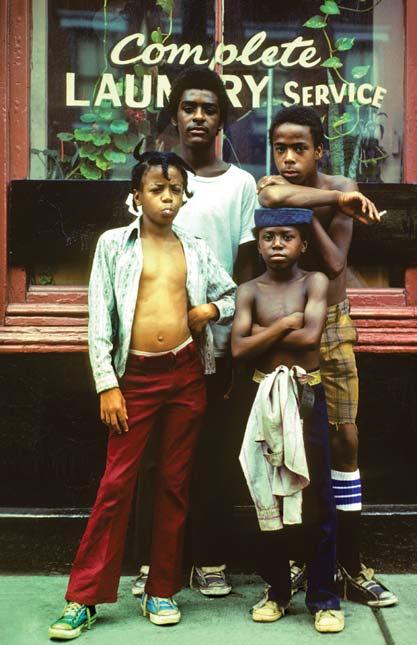
SEELBACH: It’s one of the few places in the region where you don’t have to have a car.
RICO GRANT (owner of OTR businesses Gallery at Gumbo and Cinema): The neighborhood’s walkability is absolutely incredible. You can park a car or ride a bike and just sort of move around freely, go from meeting to meeting—do whatever you need to do socially or workwise.
VALARIE DOWELL (OTR resident for 35 years): I’ve been here so long, and there are good changes and bad changes. The neighborhood feels safer to me. I have 10 grandkids, and six of them are always at my house, especially on the weekends. They’re able to go out and walk to Findlay Market and feel safe—that’s important to me.
WASHINGTON: I feel like we’re a neighborhood at a crossroads. Let’s be honest, as beautiful, neighborly, kind, and creative as this neighborhood is, there is the perpetual struggle of equity in common spaces.
DOWELL: I know development has to happen to bring about change in the community, and I understand the stability piece. What I don’t like is when you do it on the backs of people who have been here a long time. You’re making everything unaffordable.
JOE GIRANDOLA (president of the Art Academy of Cincinnati): My biggest concern is continued access to improved safety. Work/life balance in OTR is a challenge when the lights go out and the restaurants close; Art
“This neighborhood is really about commitment. A lot of people have dug in their heels and stayed here through the struggles.” —JOSE SALAZAR
WE WERE YOUNG ONCE Main Street in 1975.
14th & Main
Academy students live here 24 hours a day.
SALAZAR: Parking is an issue for people who live and work here. Business owners can’t get parking permits. My employees are always struggling to find affordable parking.
DECLAN TOM (staff member for City Councilmember Mark Jeffreys): I think it comes down to a struggle between making or maintaining OTR as a kind of common ground for everyone in the
city and reflective of the other 51 neighborhoods, while at the same time staying true to the families that have been in this neighborhood for years and generations.
MATT RECKMAN (president of property management at Model Group) : The city could be more proactive than reactionary on keeping up with the evolving neighborhood. As neighborhoods change, you have an influx of resi-



dents and customers to an area that hasn’t seen change in many years. This means city functions like transportation, public right of way lighting, trash receptacles, crime and safety, and zoning uses need be looked at comprehensively, with adjustments made quickly to capture positive momentum.



MARKIEA CARTER (the city’s director of community and economic development): When thinking about



the future of OTR, it can be helpful to look back at parts of the neighborhood where we’ve already seen signifi cant development and learn from those stories. The examples of transformational development that went well are almost always because of a mix of leveraged investments, partnerships, and collaboration with engaged residents. By comparison, we can look two

blocks over and see what it’s like when we didn’t have such a collaborative approach.
DONNA HARRIS (director of the Over-the-Rhine Museum): I live here because this is a fun, funky, beautiful community with a rich history. I just hope we don’t lose the stories and sense of community as new residents move in.
NEFF: Humility can be a challenge. What are the interests where there might be some
overlap? It’s a vibrant and exciting neighborhood, but I don’t think we should assume it will always be such, unless we’re really thoughtful about it.
How can the neighborhood improve?


W. KEVIN PAPE (president of the Over-the-Rhine Foundation) : One thing the






CONTINUED ON PAGE 38

Vine, McMicken, &



foundation did years ago was put together an owner-occupied initiative. The whole idea was to recognize that, yes, 3CDC has made a major investment and there are a lot of big developers in the neighborhood, but one of the things that’s really key to making a beautiful, inclusive, and organic community is ensuring that small developers and families have the resources and the
knowledge to have a path forward to owning a building as well.



TISSOT: In my experience with city leaders, they really aren’t focused on home ownership for people who have been in the neighborhood for decades or even retaining the homeowners we do have.


CARTER: With regard to infill development, we’ve learned the entire process takes time
to get right. So we try to engage with potential developers earlier—often before we even put out an Request for Proposal, an RFP—to hold time and space for key community engagement. We’ve had conversations where we look at an empty lot and think, from our perspective, it would be perfect for infill development. But various community stakeholders and residents
Findlay


Home to Company 5 of the Cincinnati Fire Department, the oldest professional fire department in the United States.
may have a different vision for that space that better serves the neighborhood. With more time on the front end, we can ensure open dialogue about density, infill, urban gardening, green spaces, and more, hopefully determining a collective vision for the piece of land.






DOWELL: We need to think of senior citizens, because it just breaks my heart when people
who have lost their housing are 60 and 70 and living in a shelter. I understand we have to make way for younger people to get into the community, but we’ve got to figure out a good balance.
DARDEN: Ownership of the building where I live changed a couple of years ago, and they don’t want anybody outside. I used to be able to sit outside and talk to my neighbors
and connect with people and have conversations. I truly miss that. Sometimes you meet new people and you strike up a conversation—that’s what life is supposed to be about.

Re-evaluating Over-the-Rhine’s Full History
the story of the everyday people who lived here.”
With the help of a Ohio Humanities grant, the museum has researched the buildings and will recreate their rooms to reflect the lives of real people who lived there between 1860 and 2020. That includes the Fettweises starting in the 1860s, but also a Jewish family who moved in and became the landlords in 1927; Appalachian tenants who occupied the apartments in the 1950s; a biracial family who rented there in the 1990s; and many others in between. The museum plans to open to the public within two years.
With each room, the museum aims to uncover, present, and preserve the heritage of Over-the-Rhine, says Anne Delano Steinert, the museum’s founding board chair and research assistant history professor at the University of Cincinnati. She’s an expert on Cincinnati history and architecture and one of the urban historians actively working on the project. “The idea is to build empathy and understanding in the present and for the future through an understanding of the past,” she says. “Every story we’ve unearthed contains universal narratives of the strengths, struggles, and survival of all Cincinnatians.”
THE THREE-STORY BUILDING AT 3 W. MCMICKEN AVE. IN OVER-THERhine has seen a lot since it was constructed by German immigrant Carl Leopold Fettweis more than 150 years ago. He built it to house his stone-carving business, but over the years it’s also been a flower shop, a dry goods store, a soup kitchen, and a church. It was even the scene of a murder.
At least 150 different families have called this property home since it was built as an apartment tenement building, with Fettweis’s single-family residential structure behind it fronting Findlay Street. They’re now owned by the nonprofit Over-the-Rhine Museum, which is transforming them into an immersive museum experience to help visitors step back in time to different eras of the neighborhood’s history.

“People may know the stories of Cincinnati’s famous beer barons, but they don’t know much about the work of midwives in the 1800s or living in a small apartment with five or more children or running a cigar-rolling business,” says Museum Director Donna Harris. “We want to tell
ANOTHER GENERATION
Solomon
CARL LEOPOLD FETTWEIS AND HIS WIFE ANNA ARRIVED IN 1847 FROM Baden-Württemberg, Germany, part of a wave of 30 million German, Irish, and Scandinavian immigrants who came to the U.S. between 1840 and 1850 to flee famine, religious persecution, or political conflict. Cincinnati was the sixth largest U.S. city at the time, and industry and trade boomed thanks to transportation options on the Ohio River and the Miami and Erie Canal.
Fettweis’s first building, a tiny two-story structure with five rooms, no bigger than 12 feet wide, was a private residence, eventually housing his family of nine. He added the three-story tenement building next to the

The neighborhood’s long and varied story can be told through the many people who called a single property near Findlay Market home.
—CARRIE BLACKMORE SMITH
house in the 1870s and ran the family’s stone-carving business on the first floor and side yard and rented out apartment space above.
Renters included the Rezacs, Austrian and Czech immigrants who had three daughters, one of whom became a famous circus performer in 1894. A family of five that came in a later wave of German immigrants in 1915, named the Moerleins, were distant cousins of Christian Moerlein, the famous brewer. One of Carl’s sons, Leopold, left an imprint on the city with various stone carvings still on display today in Inwood Park and Washington Park and the impressive 25-foot-tall sculpture on the
of the people who could afford to leave Over-the-Rhine were leaving, electing to move to new neighborhoods developing on the hills above the river valley. Members of the Fettweis family, for example, moved to Corryville, along with many other Germans.
By the mid-20th century, Over-the-Rhine had become a neighborhood primarily made up of poor Appalachians recruited from towns in Kentucky, Tennessee, and West Virginia to fill Cincinnati factory jobs that had been vacated by soldiers going to war. These new residents were looked down on for their rural dialects and unfamiliar vocabulary and were often discriminated against for jobs. “There was a huge cultural disconnect,” says Steinert. “They had real wisdom in the art of how to survive in a rural setting, but a lot of that knowledge was useless in an urban one.”
Low-wage jobs and poor living conditions became the norm in Over-the-Rhine. Many lived in poverty, including Anna Riggs, who occupied the smallest apartment in the McMicken tenement in 1956. She shot and killed her husband Eugene at the top of the building’s main stairwell on February 10 of that year after he refused to trade in their 8-inch television for a 21-inch one, according to newspaper reports.

THE NEXT WAVE OF OVER-THE-RHINE RESIDENTS WERE mostly Black, those who got displaced from homes in the neighboring West End. Residents of the urban core left for newer suburbs after World War II, and the population decline resulted in less city tax revenue. Cincinnati’s response was an urban renewal project in 1958 that demolished a 400-acre section of the West End, called KenyonBarr, to make room for the construction of Interstate 75 and a new industrial area dubbed Queensgate.
Germania Building at 12th and Walnut streets.
Solomon and Rebecca Kabakoff purchased the property from Carl Fettweis’s granddaughter in 1927 and moved in with their five children from another part of Over-the-Rhine. Rebecca and Solomon had emigrated separately to the U.S. from towns in Russia.
The Kabakoffs added the storefront that can be seen from the street today. Inside, Rebecca ran a dry goods store and Solomon worked as a tailor and furrier. The family was Jewish and spoke Yiddish in the home. They attended a synagogue in the West End and, after it closed, another in Avondale.
After Rebecca died, Solomon sold the building and moved with his second wife to Avondale in 1955. Most
By the 1980s, about half of Over-theRhine’s population was Black and half white Appalachian, with some Germans and Italians scattered about. Nearly half of the population was elderly, and the neighborhood was solidly low-income.
The Rachel family lived in one of the tenement’s apartments in the 1990s. Donald Rachel was Black, and wife Sherry was white. They lived in the apartment with her young daughter from an earlier relationship and his niece, whom they’d adopted and was in a wheelchair.
The last official tenants moved from the Fettweis properties in 2008, Harris says, but when the museum bought the buildings in 2020 it learned others had lived there. “We know people were squatting in the building,” she says. “One room is all covered in graffiti, and it’s actually quite beautiful. We’re going to leave it and tell that story as well.”
14th & Republic
the cops called on me for parking in my own loading area. The residents just say, Well, we live here now. HARRIS: People who move here from other places should connect with the history and embrace the culture, art, and walkability of our neighborhood.


PAPE: Literally half of Over-the-Rhine is still vacant parcels that can be built upon.


And a lot of that is happening, which is a good thing. Fill in the gaps, but do it in a way that’s informed and contributes to the neighborhood. A lot of what I’m seeing are developers coming in from the suburbs and bringing that suburban design aesthetic, like putting a garage right in front of the house.
SEELBACH: As we grow and more people come
into this neighborhood, it should reflect the broader community, not just the people who can afford $500,000 condos. We want people of all income levels and businesses supporting all levels of income as well.
DAVID VISSMAN (OTR resident who manages cleaning and events operations in 3CDC’s improvement districts in OTR and the Central Business District) : The neighborhood could use more housing for people of


IT’S LOW-KEY HERE, JUST A BLOCK FROM THE HUSTLE AND BUSTLE OF VINE STREET—WITH A FEW NOTABLE EXCEPTIONS. —AIESHA D. LITTLE
all income levels, which is why 3CDC has been so focused on mixed-income housing projects over the past several years. Creating multi-bedroom units can be challenging in the historic buildings that make OTR such a unique neighborhood, but it would be great to see more of those whenever possible.



GRANT: The inclusive work has to continue.
As the business community continues to thrive, it has to get blacker and browner. There was a time when I would walk a block and a half from one of my two Over-theRhine locations before I passed another Black-owned business. That’s not the case anymore. I look across the street and my neighbors are African American, and that really matters.
SOMERHAUS

OVER-THE-RHINE COMMUNITY HOUSING PLAYGROUND

For children living
properties,




When you imagine the Over-theRhine of the future, what do you think or hope
it will look like?
STEINERT: I would love to see every single building that exists today exist in Overthe-Rhine in 100 years. That we never tear down another historic

Liberty & Walnut
building and instead figure out how to become more creative and innovative to work with them rather than against them.


MALONEY: Could this neighborhood be a rare example of successful mixed-income development?

DOWELL: I was a little kid when they took the West End [to create Queensgate]. During those times, Black people weren’t allowed
to cross Central Parkway. Today there are small pockets of the Black community in Over-the-Rhine, but they are reducing a lot of them. I think it’s going to be, I can’t even say middle class, but more wealthy people controlling Over-the-Rhine. I hope not, but it’s moving fast.


DARDEN: We want to be seen as equals to those with fi nancial wealth. I was raised
differently. If you have people who love you and care about you and you can link with, you have wealth.


NEFF: Diversity of users and owners, but also diversity of uses. I’m a member of First Lutheran Church, one of those precious places in the neighborhood that is truly open to everyone. My hope would be in 50 years we’ve preserved these places—not just the



WILL REDEVELOPMENT OVERTAKE THIS CORNER, WHERE RESIDENTS FILL UP WITH GAS, RECEIVE SPIRITUAL SUPPORT, AND VISIT A FOOD PANTRY? ONLY TIME WILL TELL. —JOHN FOX




Gas and a market, open 24 hours. If new development comes to this corner, the next closest gas station is in Queensgate or Walnut Hills.
bricks, but the uses. That’s really essential to this being the thriving, interesting neighborhood that it is.


STEINERT: The buildings and the uses are the key. There’s enough housing for lowincome people and wealthy people. There’s enough room for this kind of art and that kind of art. There’s enough room for recreation and whatever. Over-the-Rhine has




the capacity to do all the things, but we keep thinking about the future as a dichotomy of It’s only good for this or that.

PAPE: These buildings have a patina and are tangible evidence of generations of people who have lived, worshipped, worked, and invested here to make it what it is. So we come back and reinvest in those buildings and carry on that tradition. When you’re
Founded in 1872 and known for its gorgeous leaded glass entryway and wooden bar, the gathering spot closed in 2011.

Built in 1866 as the Baptisten Kirche, the building now houses a Christian denomination dedicated to serving the neighborhood.
The nonprofit organization’s Liberty Street Market serves up to 300 families daily and more than 88,000 individuals annually.
out walking or driving or experiencing Over-the-Rhine, you’re experiencing this 19th-century neighborhood—but as we begin to fill in all these vacant places, it will take on a very different character. We have to be conscious and conscientious about how we do that.
Read a longer version of this discussion at cincinnatimagazine.com
12th & Elm


KEEPING OTR’S CHARACTER INTACT
The Over-the-Rhine Foundation points out that since 1930, roughly 50 percent of the neighborhood’s building stock has been removed, much of it taken down by the city after sitting vacant and threatening to collapse—what the foundation calls “demolition by neglect.” As OTR became attractive to real estate developers in recent years, many of them built “infill” projects on those
empty lots—and some don’t really fit in with the neighborhood’s Italianate architecture. Preservationists realized there was a problem: The city’s guidelines for new construction in OTR were out of date and out of step.




The city of Cincinnati passed a new ordinance, Conservation Guidelines for the Over-the-Rhine Historic District, which took effect on July 8.
Douglas
to understand with the new rules. “We focus on the block that any empty lot sits in, meaning the new building should fit in with the surrounding historic buildings,” he says. “Not some buildings four blocks away, but the ones right next to it.”



SCPA
It took 15 years to raise the funds to construct the nation’s first K–12 public arts school, which consolidated programs in Pendleton and Corryville here in 2010.
GUIDELINES FOR CONTEXT INCLUDE:
MASSING, HEIGHT, AND SCALE
OTR’s tall, long, narrow buildings were designed to maximize residential and business density. Typical blocks have buildings three to four stories in height, though some are shorter and others taller.
SETBACK
The vast majority of residential buildings were built up to the sidewalk, with zero setback. Some larger iconic churches, schools, and public buildings were set back to provide more of a monumental scale.
COMPOSITION

Typical OTR buildings have a recognizable base (different looks for residential and retail ground floors), middle





(horizontal lineup of windows and sills), and top (including OTR’s famous Italianate cornices).
RHYTHM
The repetition of tall, narrow buildings of varying height and projecting wall surfaces results in a particular pattern, or “rhythm,” on OTR blocks.


MATERIALS
Exterior surfaces should reflect the block’s prevalent look, especially brick

but also limestone, sandstone, wood, metal, and cast iron.
Owen evaluates every building permit application for new work in Over-the-Rhine and makes a recommendation of approval or modification to the Historic Conservation Board, which must approve the project before it receives a city permit.

Brooke Barganier Sees With Her Eyes and Understands With Her Heart







































The pediatric nurse focuses on giving— to family, friends, and patients— despite a lifetime of struggle.
 By Carrie Blackmore Smith
By Carrie Blackmore Smith






In her 43 years, Barganier had survived 23 surgeries, endured more radiation treatments than she could count, and watched helplessly as the tumors growing inside her head deformed her face and the steroids she took to fight them changed her body. She lost vision in her right eye at age 14 but had persevered to become a pediatric nurse and a devoted wife, daughter, and friend.
She’d made it this far. But complete


blindness? That would require a whole new level of trust, the South Lebanon resident thought as she lay sobbing on the floor. Trust in her doctors. Trust in her God. Trust in her purpose.
She lay there for maybe an hour, mourning the loss of sight in her quiet house, her husband John at work. Finally, she decided not to remain on the floor. “I got up,” says Barganier, “and figured out how to gather up all the pieces of the plate.”
Barganier had been the kind of kid who stuffed socks in her shoes to be tall enough to ride roller coasters at Kings Island. Outgoing, she never met a stranger, says her mother, Debby Schaefer. “This would never happen nowadays,” her mother says, “but we were flying to Florida and she was 10 months old, just so happy and bubbly. She got passed around the plane.”
Until 10, she was living a “normal” childhood, attending Lakota Local Schools in West Chester Township. Then headaches started keeping her from soccer practice and sleepovers. Her right eye slowly started to protrude.

Alarmed, her parents took her to an oph-





thalmologist, a doctor who diagnoses and treats eye and vision conditions. He referred them to Cincinnati Children’s Hospital, and so began a lifelong queue of doctor’s appointments and medical procedures.
By 15, Barganier was diagnosed with complex meningioma, non-cancerous tumors that grow on membranous layers that line the brain. These tumors are rather common and typically grow slowly. Many don’t ever require medical intervention. Barganier, on the other hand, had an aggressive case.
“At school they called me Frogeye,” she says. “I’m not gonna lie. It was hard in high school to be left out of certain things with friends, because they were embarrassed of how I looked.”







Barganier says she might not have made it through without her parents, who were always building up her confidence, and a steadfast group of friends in her youth group at Faith Bible Church in Sharonville. They, like her parents, didn’t treat her differently as her condition worsened.
By senior prom, Barganier had been through craniofacial surgery and an orbital decompression and was undergoing radiation treatments to try to shrink and slow down the growth of the tumors. No one had asked her to the dance, so she wasn’t going. But she offered to do a friend’s hair and sat, weaving an updo and listening, as a friend complained about a tiff she was having with her date.
Before the cameras could flash and corsages could be pinned, Barganier drove home. She stormed to her bedroom. Her father followed. “What’s wrong?” Dale Schaefer asked.
“Everything,” said 17-year-old Brooke. Her hair had fallen out. Radiation caused constant vomiting. These tumors might kill her. Her friend’s problem was so small. So petty.


Barganier remembers her father hugged her and was quiet for a while, before saying something that would stick with her and begin to mold her outlook on life. “He said, I’m sorry, but you’re going to have to learn something.Right now, your friend fighting with her boyfriend IS the biggest problem in her life. What you deal with will be on a larger scale, but you’re going to be a very bitter woman if you don’t figure out how to understand that.”

The Fiesta ware plate crashed to pieces on the floor. Alone in her house one afternoon in November 2021, Brooke Barganier shooed away her sweet Labrador retriever, Allie, and then slumped to the floor as well.
Brooke Barganier, now 45, jokes that in heaven God will remake her in the image of Cindy Crawford. Humor has always been a tool, she says, to help put people around her at ease and help her cope with the stares and averted eyes.

Through the years, she’s built a resolve that whatever is going on in her life medically and however she looks is just temporary. She wholeheartedly believes that God gave her this life—these burdens—for a reason.








One part, she thinks, was so she’d become a nurse. Early on in her medical journey, Barganier decided to make it her profession. One particular experience sealed the deal.







She was 14 and recovering from craniofacial surgery in Michigan, which required laying completely flat after the procedure, as fluid drained from her brain. “It was about 10 p.m. and I was having a terrible night,” she remembers. “I called my parents at their hotel and said, You have to come back.”

They told Barganier they couldn’t. They were exhausted and had to rest. Word of her struggles traveled to a nurse who’d come in for a shift but wasn’t needed. Instead of going home, the nurse sat, off the clock, and read to Brooke until she was ready to sleep. “As a nurse, you’re interacting with people at their most vulnerable moments in life,” she says. “And you have this ability to be able to make it better just by being there.”



Barganier graduated from the second to last class of the combined Lakota High School and attended Ohio State University for a year before moving back home, where she finished an associate’s degree in nursing and science at Raymond Walters College (now UC Blue Ash). She passed the National Council Licensure Examination and became a registered nurse in 2000.
Her first job was at Jewish Hospital in the bone marrow transplant unit, and then she worked at Cincinnati Children’s Hospital in the neurosurgery unit before transferring to oncology, where she helped treat children suffering from cancer. Today Barganier serves in
 A Bright Light Brooke Barganier (opposite page) grew up in West Chester and started experiencing eye issues around age 10. Friends and family have supported her through multiple surgeries (above), and today she supports families facing same-day surgery at Cincinnati Children’s Liberty Campus (below).
A Bright Light Brooke Barganier (opposite page) grew up in West Chester and started experiencing eye issues around age 10. Friends and family have supported her through multiple surgeries (above), and today she supports families facing same-day surgery at Cincinnati Children’s Liberty Campus (below).
Fantastic Botanical Beasts and How to Build Them










 By Jaclyn Youhana Garver
By Jaclyn Youhana Garver




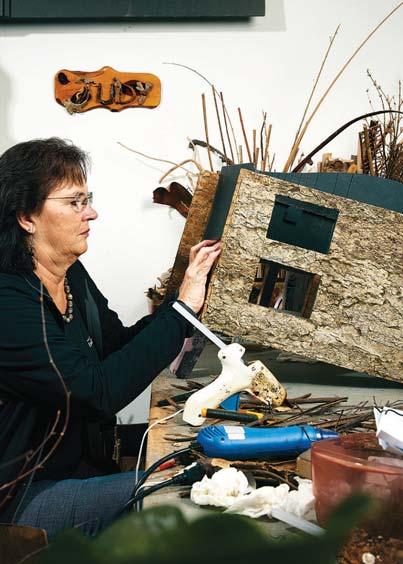








At Applied Imagination in Northern Kentucky, the creative brains behind Krohn Conservatory’s popular holiday show, the whimsy is a family affair.LAURA BUSSE DOLAN AND PAUL BUSSE KIERAN BEAM JUDY EGLIAN PAUL BUSSE’S VERY FIRST BOTANICAL MODEL DIRK PETERSEN AT BILTMORE ESTATE IN ASHEVILLE, NORTH CAROLINA KROHN CONSERVATORY
THE LITTLE HOUSE STANDS
less than two feet tall. In size, if not aesthetic, it’s comparable to Barbie’s dream house. Dried moss grows organically around the edges of honey locust pod shingles. Sticks trim a door made of bark, a tiny pinecone centered at the top like a jaunty fl ower. Just to the door’s right, a small window holds glass made of poured resin, with mullions of winged euonymus—better known as burning bush.































There are no precise right angles, which adds to the feeling that a gnome might poke her head out at any time and invite us in for a sip of tea. Or dew. Or whatever it is gnomes drink. If it’s being served in this house, it’s going to taste like fairy dust and honey.
This botanical model is the fi Paul Busse built, in 1991. It lives in his daughter’s office, a reminder to Laura Busse Dolan and everyone else who works at Applied Imagination of the company’s roots— and seeds.
On its website, Applied Imagination calls its creations “installations.” The buildings and creatures made of botanical materials are meant to pair with model train displays. During an August visit, the artists and staff worked on a model of the




National Underground Railroad Freedom Center to add to the Krohn Conservatory’s holiday show. (The display of Cincinnati building miniatures opens on November 11.) Applied Imagination has also worked with the New York Botanical Garden since 1992, and it has pieces in such locales as the Biltmore Estate in Asheville, North Caro-
lina; the U.S. Botanic Garden in Washington, D.C.; and the Chicago Botanic Garden. These details, though, don’t quite capture the art of what’s created in the workspace in Alexandria, Kentucky. It’s one thing to see, for example, the 8-foot Tyrannosaurus Rex that greeted visitors at the Krohn Conservatory this summer, a dino-
saur that, unless you looked really closely, appeared to be made of the same material as a dino at any museum space.



















It’s quite another thing to watch Kaitlin Peed Schmidt stand on an 18-inch tall hunk of Styrofoam and use a reciprocating saw to round out what will turn into a red spotted mushroom cap, with horse chestnut serving as the white dots. She’s working on one of those 90-plus-degree August days. To shape the mushroom-cap mound, she has to duck out from under a portable tent set up to keep the most brutal of the sun’s rays from baking her skin.
The ground is littered with piles of foam flakes. They dust the grass and work table, coating her forearms and the front of her jean shorts. But this, apparently, is nothing compared to the foamstorm kicked up during the making of the Krohn dinosaurs. “As you see, it gets very messy very fast,” says Schmidt. “Those days, I would just be covered in foam. It’s very static-y. There’s
the long-neck dino you’ll see at Krohn, and there’s a picture of me underneath it [at the workshop] making a foam snow angel. We have fun.”
Applied Imagination is a company with full-time employees and benefits—time off, dental, all that—but there’s nothing “corporate” about this group. Getting to the building requires a road so winding a toddler might have drawn it. When you turn off the road, you cross a bridge, and the drive is the first on the left. “More than likely, there will be model train tracks in the driveway,” Dolan warns, “so just park anywhere, even if you have to park someone in. It’s a little full out there.”
Upon arrival, Maple greets you. She’s a mutt, though there’s almost certainly some lab in there, and you swear the dog smiles when she sees you. She’ll allow a pat, but this isn’t a dog that wants to cuddle. Maple wanders the workshop, inside and out, like she runs the place.
She’s 3 years old and belongs to Schmidt, who’s had her since the dog was about three months old. Maple has been going to the workshop for nearly that whole time. She and the other animals lurking around—including a cat named Garfield—add to the sense that Applied Imagination is a family air.

PAUL BUSSE LAUNCHED THE company in 1991, just a year before he installed his first pieces at both Krohn and New York Botanical Garden conservatories. It’s been 31 years, and both of those shows are still running today.

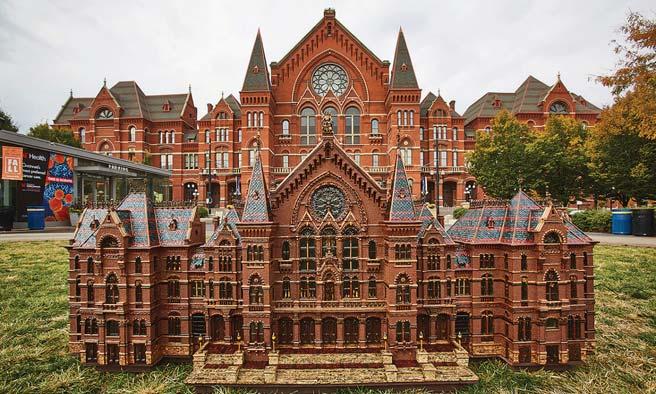
Busse, whom Dolan calls the company’s “founding visionary,” studied architecture at Miami University. When he realized he didn’t want a desk job, he transferred to Ohio State University to study landscape architecture. He entered the field back in the 1970s to design creative residential living spaces; think of a gorgeous backyard with a giant deck, a patterned brick patio, and bright landscaping.

Applied Imagination mixes landscape architecture with Busse’s lifelong obsession with trains. “I can remember as a kid we would go stand at real train tracks and wait for a special train to come through town that would rush by,” Dolan says. “That was the most thrilling thing as a kid, seeing real steam trains with my dad.”
He loved small trains, too. Applied Imagination CONTINUED ON PAGE 61

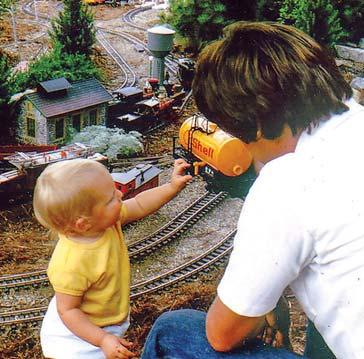







FALL

November 7–10 | 6–10 p.m.






Our lavish four-night dinner series returns to celebrate the bounty of Fall. Be sure to #savorthedate for this
HILTON CINCINNATI NETHERLAND PLAZA HOTEL

CINCINNATIMAGAZINE.COM/SAVOR

PRESENTING SPONSORS



SPONSORS





the same-day surgery unit at Children’s Liberty Campus. She helps prepare kids and their caretakers for all sorts of procedures—from sports-related anterior cruciate ligament injuries to ear tube insertions—that don’t require an overnight stay afterward. She helps them prep for surgery and get safely home with the medications and information they need.
Her personal health journey allows Barganier to be compassionate with patients and their parents, says Ann Niehaus, who’s worked alongside her for 11 years. She is amazed how quickly Barganier can dial in on a child’s interests and bring comfort
When Barganier isn’t feeling great or is preparing for a big procedure of her own, she might get a little quieter, a little more serious, Niehaus says, but not by much. “And she never complains. She considers work a privilege.”
Another colleague and friend, Sandra Sayers, says she’s constantly inspired by Barganier’s bravery in the face of the unknown. “She is more stressed out by a messy toy closet than brain surgery,” says Sayers, who wasn’t surprised when Barganier was awarded the hospital’s Patient and Family All-Star Award in 2021 for the amount of positive feedback she received in surveys. “When she came in to receive this award, she was actually on medical leave,” Sayers says.
Barganier’s face was swollen more than usual. Even under masks because of COVID, everyone could see. “Everything is out of her hands, you know, but she comes in and she says, I’m bringing sexy back,” Sayers says, laughing. It’s so Brooke, serving up levity and humor.
through the seasons of your life,” Dysart says. “Not Brooke.”

Their shared faith is a big part of their connection, Dysart says, but she also loves Barganier for being a riot on road trips and inspiring her with an effervescent can-do attitude.
Barganier has bad days, but she stays focused on her belief that God has a plan— even if she can’t see it. It’s been hard to accept her path sometimes, she says. She and her husband decided not to have children— a really tough one—because her condition made it dangerous for both Barganier and any child she would carry. There was one miscarriage.
If they were being honest, they didn’t know how long Barganier would be around. That seemed unfair to a child.
About eight years ago, doctors decided it would be best to close her right eye permanently to avoid infection. Until then, despite not working, the eye had looked normal. Barganier found herself again wrestling with her outward appearance.
“I had a really hard time with it,” she says. “I’d look in the mirror and almost be like, Who is that? But then I had to say, You’re not 13, get over yourself!”
to his or her caretakers. “She knows all of the kids’ favorite toys and shows,” Niehaus says. “She talks sports with the older kids, manicures and pedicures with the teenaged girls.”
Connecting with her patients has always come easily, Barganier says, but other parts of becoming a nurse weren’t. “In nursing school, I could not get the depth of the needle to the vial,” she says. “I asked my professor if I could have a vial and a syringe to take home, just for the night. I stuck myself a bunch of times.”
But she practiced and learned her own way. In her 20s, though her face was minorly distorted, Barganier’s blind eye still looked normal. Her instructor had no idea she was blind when she asked to take home the simple medical equipment. “A lot of people were like, How are you going to put in an IV?” she says. But she got it.
As her sight diminished, Barganier reluctantly took a medical leave from work. She didn’t know if she’d be able to return.
IT WOULD BE EASY FOR BARGANIER TO play the victim, says her friend of almost 40 years, Reba George Dysart. If anything, she downplays her troubles. “She has faith it’s all part of something bigger,” Dysart says.
The two met at Faith Bible Church, where they participated in a youth group and went on mission trips. They danced nights away at clubs around Ohio State University their freshman year. Dysart later counted on Barganier to lend a hand when she had “Irish triplets”—her first child and then, less than a year later, twins.
Barganier was there when Dysart’s parents died in quick succession from cancer and stuck by her through her divorce. “There are many people who come and go
One of the greatest influences in her life was another best friend, Leah Kirk. “She said, Maybe that’s God’s way of sharing your hope and faith with other people,” Brooke says. “She said people were going to look at me but I could use that to get their attention.”
Six months after the procedure on Barganier’s right eye, Kirk died of breast cancer.

Again, life had its way of putting things in perspective. Barganier was alive. She could continue choosing hope and joy over defeat and anger. Even if she was going blind, she could be grateful for this life and her place in it.
As Barganier’s vision dwindled, imaging of her head showed a tumor had grown to the size of a fist and was impinging on the optic nerve of her left eye. She and her father made an appointment to see Karl Golnik, M.D., her longtime neuro-ophthalmologist at Cincinnati Eye Institute.
Barganier had been seen and operated on by some of the top medical specialists in the region and traveled to hospitals in Detroit and Houston for some of
BROOKE CONFRONTED CHOOSING HOPE AND JOY OVER DEFEAT AND ANGER. EVEN IF SHE WAS GOING BLIND, SHE COULD BE GRATEFUL FOR THIS LIFE AND HER PLACE IN IT.
A full plate fills an empty spirit


The holidays can be a lonely time for our homeless and hungry neighbors. Let them know someone cares by providing a meal and hope today.

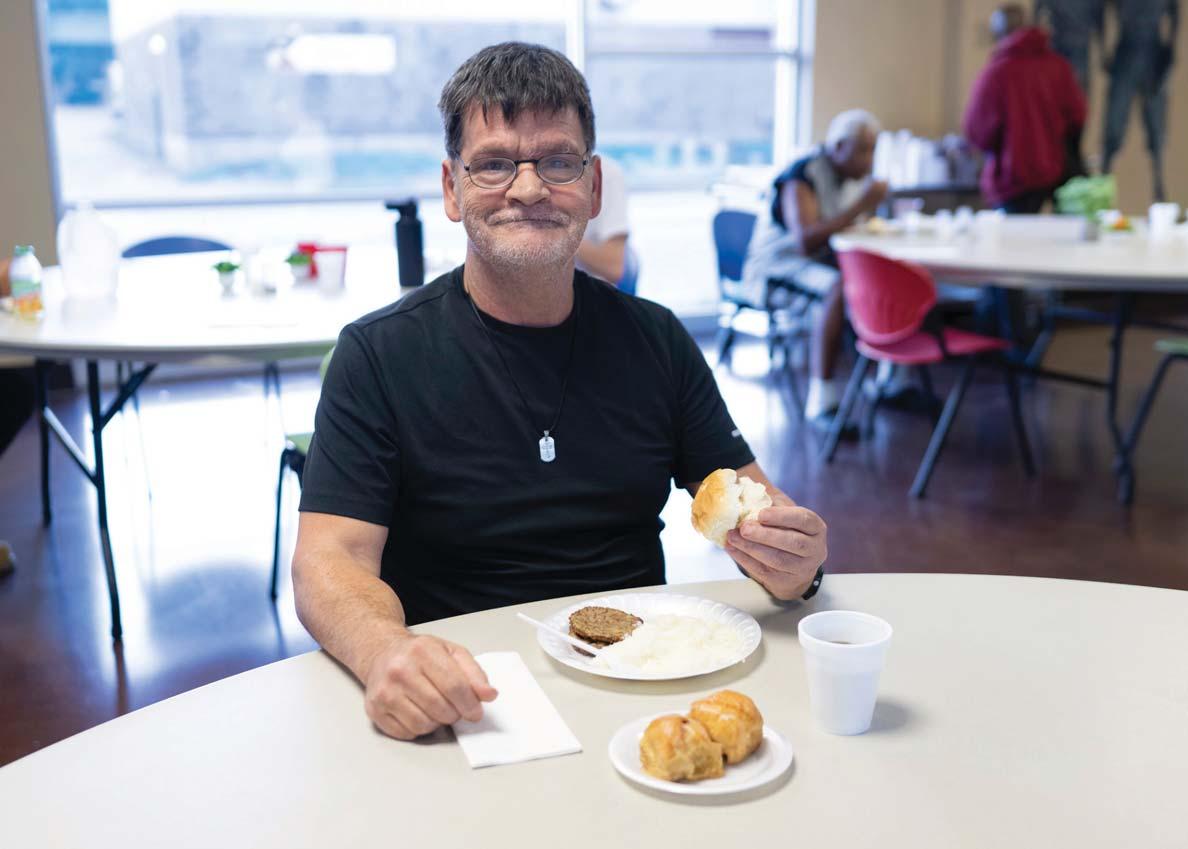
her procedures. Her case is referenced in medical journals and has been presented at Johns Hopkins University, the University of Pittsburgh, and other medical institutions.
Here in Cincinnati, she’s undergone several craniotomies, removal of part of the skull to treat the tumors, and multiple Gamma Knife radiosurgeries, where nearly 200 beams of radiation target tumor cells. Her care has been coordinated since she was 18 by neurosurgeon Ronald Warnick, M.D., at Mayfield Brain & Spine in West Chester. Barganier considers him family. “Her team of doctors has been following her for 25 or 30 years, but it seemed like the writing was on the wall,” says Golnik, who recently retired from practice. “One doctor told her it was time to learn Braille.”
Barganier’s father noted that her left eye was really bulging, and something clicked for Golnik. With a totally different medical condition called thyroid eye disease, the eye muscles and fatty tissue behind the eye can become inflamed and cause the eye to bulge. In rare cases, it can cause blindness, but surgeons can go in and remove bone, essentially deepening the eye socket, to allow for more space for the tissue and the optic nerve. Could something like that work?
It just might, thought Mayfield neurosurgeon and brain tumor specialist Vincent DiNapoli, M.D. Together with Jeff Nerad, M.D., an ophthalmic surgeon at Cincinnati Eye Institute, and Philip Theodosopoulos, M.D., then-director of skull base surgery at the University of Cincinnati, the doctors designed a surgery just for Barganier.
“Skull base surgery is a dangerous business, for sure, because we’re operating around arteries that supply the brainstem and the critical parts in the brain that allow us to be awake and to function,” says DiNapoli. Return of her sight “was a bit of a long shot.”
As with many of Barganier’s procedures, there was a slight chance of death. She and her husband prayed and decided to proceed.
After Barganier woke up from the four-plus-hour surgery, she still couldn’t see, but that was expected. If the procedure had worked, her vision would return eventually after things healed up and the
inflammation receded.
The day Barganier dropped her piece of Fiesta ware was six weeks after surgery. She couldn’t help but think it hadn’t worked.
AT DIFFICULT TIMES LIKE THESE, BARganier pulls out a journal she keeps, where she logs occurrences she considers miracles and blessings. It reminds her to have faith.
Across pages of entries, she chronicles events like the time a check arrived in the mail for her father from a church friend while medical bills piled up during her high school years. The friend knew the church community was praying for Barganier and her family and said he heard a calling to sell stock and give the money to the Schaefers. He didn’t know how much the family needed, but it was just enough to get them through that month.
Barganier was also a recipient of the Special Wish Foundation, which paid for one year of college as well as room and board at Ohio State University, allowing her to have a taste of the college experience (which her family couldn’t afford) with her best friend, Dysart.
And there was the time Barganier’s mother got the urge to pray that a tumor would “just fall off” during a procedure. The family asked their prayer team to do the same, and Theodosopoulos reported back that, after one slice, the tumor fell away and they were able to cut it up and remove it— something he’d never seen before.
One her first date with John, Barganier joked that a life with her would never be boring. Earlier that day—out of the blue— she had called and said she was in Mobile, Alabama, where he lived.
The two had met eight months earlier in an AOL Christian chat room and had been routinely talking on the phone. Surprise! She was in town from Ohio! Not boring at all, John thought.
“I had dated other women, but I hadn’t found one I wanted,” says John. “I wasn’t going to just marry anybody.” After Brooke returned to Lebanon, he realized he missed her and valued their time together. It wasn’t long before Brooke called and asked him to find her an apartment near him. “I don’t know what happened up here,” John says, meaning Ohio, “but, excuse my
French, I think all hell broke loose.”
Brooke told her parents that she had met a man from Alabama who was a little older and she was going to move there so they could date. Dad heard “chat room” and got worried. Both parents traveled with her to help her move into her new place and to size up John. Dale Schaefer can say for certain, 20 years later, John was a miracle in and of himself—the husband for his daughter he’d prayed for.
Brooke told John her medical condition would dog them for life. John said it was a part of her, and he loved all of her. They would take it as it came.
On a morning in December 2021, about three months after the surgery to restore sight in her left eye, Barganier woke up and made her way to the bathroom. To her astonishment, she could see the outline of her face in the mirror. Blurry, but there.
In the days that followed, she started seeing small flashes of light. Within weeks, her left eye was back to 20/20 vision. She was finally able to return to work. That one definitely went into the miracle journal.
There’s no way of knowing how long Barganier will keep her sight, says DiNapoli. Her life expectancy is also hard to pinpoint, because it depends on how her tumors grow. But her dad thinks that not knowing if tomorrow is coming encourages one to enjoy life more. His daughter has shown him that since she was 14 preparing for her first surgery. People who know Dale and his family ask, “How is Brooke?” He answers, “Today is a good day” because she’s still here.
Her youth pastor, Keith Missel, stayed in touch with Barganier when he and his wife moved to Iowa to lead another church and then became missionaries abroad. “In pastoral ministry you don’t play favorites, but people stand out,” says Missel. “Brooke has experienced God’s presence and his power. In her brokenness, she has kept giving, like Christ.”
After all she’s been through and expects to go through, Barganier says she wouldn’t change a thing. “I mean, I could have skipped the throwing up for three days straight after brain surgery,” she says, always joking. “But, in the big scheme of things, I wouldn’t be who I am without it.”
uses G-scale trains, which are 1:24 scale and were the first model trains to run both indoors and outdoors.









Busse created his first public display in 1982, for the Ohio State Fair. He didn’t get paid for it. To save money and finish everything in time, he slept on-site in a sleeping bag, Dolan says. He borrowed trains from a friend who owned a local hobby store.







Today, Busse lives in a home about 150 feet from Applied Imagination. In 2016, he asked his daughter to take over the company. Everyone knew his time to step down was coming; Busse was diagnosed with Parkinson’s disease around 2006. Today, his Parkinson’s is late stage. He struggles with talking and walking, but his caretaker brings him to the workshop, where Busse moved the company in the early 2000s. Before then, Applied Imagination was located in the teeny basement of a carriage house in Northside.



Busse’s vision outgrew the basement, and it’s outgrown the workshop, too. “We stay here so that he can come and see what we do now and enjoy where this company is headed,” says Dolan.
Today, her office alone is larger than that original basement space. The full company includes four pole barns, each 30 to 50 feet wide and 50 to 75 feet long. The leasable collection is stored in seven storage units.

Dolan built models for Applied Imagination while in high school and college, but she never intended for it to become her full-time career. She was in advertising as a brand leader when Busse told her he wanted her to take over. “I think you’re the best fit for it,” Dolan remembers her father telling her. “We can’t clone me, but you’re the closest thing to it.”
While this path wasn’t her original plan, she says, she knows it was the right


APPLIED IMAGINATION
choice. “It wasn’t something that was ever in the cards, but now, being involved since 2017, it’s absolutely the right path,” she says. “I find so much joy in carrying on this company.”
That includes leading the team she’s assembled. In an early decision, Dolan brought back Stephanie Winters as creative director; she’d worked with Busse in the ’90s as an artist. The pair’s tight friendship goes back decades. When they tell a story, they speak over the other, praise the other, and slip off on tangents.
Dolan: “She helped me pick my first prom dress.”
Winters: “That’s how I met you. The prom dress, I was like, Let’s look at it.”
Dolan: “We bonded over fashion.”
Winters: “I was in her wedding.”
Dolan: “Maid of honor.”
Winters: “The cool thing is, we’ll come up with ideas. She’s been my muse for some stuff, too. We like fashion and music. But she’s like, I need a wedding headpiece , and I’d never made one. It didn’t exist.”
Dolan: “I wanted a 1920s, what are those called? Coronets?

Winters: “Coronet? Not bayonet.”
Dolan: “It’s like a crown. You can find them on Etsy, but they’re all destroyed.”
Winters: “Did we have Etsy back then?”
Dolan: “We did. It was the beginnings of it, but all of them were so aged, you would have looked more like you were dressing up for a haunted house. But luckily...”
Winters: “I’ll jump at any challenge.”


Dolan: “She hand-beaded this thing for me.”
In addition to 10 or so folks who serve as contractors, traveling with the company to set up exhibits from Michigan to New York, Applied Imagination currently employs about 15 full-time workers, including artists.
Tucked in a narrow space in the pole barn that also houses Dolan’s office, Annie Gessendorf is bent over quietly making dandelions from bamboo, ball gourds, and fiber optic wires. She’s drilled small holes through the golf ball-sized gourd and threads the fiber optic wires through
the holes, hot gluing them in place. A tiny wedge light is in the center of the gourd, which lights up the fiber optic ends and refracts the light through the other end of the wire, creating a glowing orb of dandelion fluff.
“This is the stuff that really gets me,” says Gessendorf. “I’ve become kind of the lighting specialist here. I’ve gotten to learn a lot over the years.”
That’s sort of how it works at Applied Imagination: When an artist gets excited about a project, Dolan lets them dive in. It’s how Schmidt, too, ended up as the primary artist on the Krohn Conservatory’s T. rex, which she named Rexy Emieran Schmidt (Rexy because, obviously; Emieran is a nod to her coworkers, Emily and Kieran; and Schmidt eponymously). Rexy served as a sort of centerpiece to the conservatory’s First Flowers exhibit, which ran July 1 to October 22. Schmidt also sculpted the forms of most of the show’s other dinos and pollinators.
“You really gotta wrap your head around how those animals’ anatomy works,” says Schmidt. “One time I did the gecko, and I just doused my brain with all these different images of the gecko to really understand their movement. I’ve always had a great love of sculpting animals, so when the dinosaurs came around, I was like, Let’s goooo! I would be the person who’d stay in college just to keep learning new things, and this place defi nitely provides that for me. There are enough different things going on and new techniques to learn that it keeps me occupied for sure.”
INSTEAD OF FILING CABINETS FULL OF documents, the workshop drawers stacked on open floor-to-ceiling shelves are full of artists’ material. Chinese wisteria seeds, lotus pod seed, hibiscus flower, and eastern red cedar are in small, clear drawers that might otherwise house nuts, bolts, and screws. Dawn redwood cones, Casuarina pods, and red canella berries are in short, wide drawers that might otherwise hold manila file folders. Cut mahogany pods, whole mahogany pods, and sweet gum balls are in tall, deep drawers that could otherwise store sweaters and socks in
your bedroom closet. Locust thorns in a shoebox-sized clear container have stiff, orange petals. They’re a cheerful pop of color among the mostly tan, sepia, and brown beans, seeds, pods, and shells.
Around the corner, bunches of tall, slim reeds and fronds are grouped in industrial-sized buckets like the warehouse section of a Michael’s. Twisty, misshapen gourds hang from a fishing net tacked near the ceiling over a doorway. Boxes of Ming moss are tucked in open plywood shelves. The moss is one the newer materials for Applied Imagination, Dolan says. As the artists are hired to make more dinosaurs, mammals, and insects, they’re also needing more materials to mimic skin and hair.
Despite the sheer amount of material, not just any botanical will work. “We can’t use any edible parts of the plants,” says Dolan. “We can use the top of an acorn, but we can’t use the actual acorn itself because little critters live in conservatories and gardens and will eat them. That’s absolutely something we learned the hard way.”
Dolan recounts an early story of her father’s: She doesn’t recall the specific building, but it included a collection of small lampposts made out of acorns. Busse came back the next day to see all the lampposts mysteriously—or perhaps not so mysteriously—gone. “Even with the coatings that we use to kind of preserve everything,” says Dolan, “the critters still found a snack.”
These art supplies come from, well, everywhere. On this late summer Friday, the company had just gotten a shipment of 100 gourds from a farmer in Georgia. The botanical gardens they work with help the artists harvest and collect materials. Applied will purchase from dry natural plant suppliers and import things they can’t get in the U.S. from a supplier in the Netherlands, and employees are known to collect botanicals themselves.
“Just last week, we took an entire day and foraged at a big property of a family member of one of the artists here and picked up cool things we can create with,” Dolan says. “A lot of times we’re just out in the forest shopping.”
They can “shop” on their own
Dealing with Fungus Nails?


How does the laser work?
The Lunula Laser targets the fungus and ser d nd stimulates new clealear nail growth. Using photochemistry, this is patented red and violet visionary laser stimulatlates blood flow and oxygen to promote healthlthy nails.
Is it painful?
No. You will only feel a slight cooling on your toes during the procedure

How effective is the laser procedure?
Current studies show a benefit in 89% of patient’s nails. The laser treatment usually takes a few months before you begin to see healthy nail growth

How long does it take?
Just 24 minutes to treat 10 toes.
What are the possible side effects?

No significant side effects have been reported.
When can I resume normal activity?
You may resume normal activity immediately following treatment. There is no downtime.
grounds, too, and they’ve planted items they harvest from often, she says. They get a lot of their pinecones from a hemlock tree out back, and the contorta bush has perfect twisty branches.
Applied Imagination is mindful of what it harvests, trying to take material that won’t affect the forest: downed trees and their bark, pods and pinecones that have fallen off branches. But the one live plant it cuts is lovingly called “ditch willow.” It grows in, yes, ditches, and helps prevent erosion. Cutting it encourages more root systems to grow, which helps the local forests and waterways.
UNLIKE OTHER COMPANIES THAT MANUfacture displays, Applied Imagination isn’t trying to create exact to-scale models. Consider that early Busse construction living in Dolan’s office, the one that looks like a home for gnomes. That’s the grownfrom-the-earth spirit that Applied artists try to capture. “We can whittle these mate-
rials down to be the exact, perfect everything, but then it’s not interesting,” says Dolan. “We might as well have made it out of plastic.”
It’s why the material selection is so important, says Winters, the creative director. “You want to express little arches and keystones and all the details, but you also want to be mindful of maintaining the natural materials,” she says. “Otherwise, it’ll just look like something that was manufactured. That’s what we’re trying not to do. Because it’s a sculpture as well. It’s an architectural model, but you want to sculpt with the plant materials.”
Take the catalpa branches on the Freedom Center project that Applied Imagination is working on during my late summer visit. To create the building’s iconic swooping roof, Winters wove catalpa, a flowering tree, to create a thatched look.
“It doesn’t really look like that in real life, right, because it’s metal siding material,” says Winters. “It’s the same color,


but that’s where we lean more toward the botanical material side and away from exactness. But when you look at it, you still see [the Freedom Center]. And then maybe it makes some kind of harmony, the two things together.”
Similarly, some of the changes the artists make in their designs serve to ensure the finished piece looks more accurate than were they to follow a to-scale blueprint. “Paul was also really big on focusing on the details that you remember most in your mind,” says Dolan. “If you look at our model of the Capitol building in Washington, D.C., you would absolutely say, This is the Capitol building. It’s a beautiful model. But he truncated the wings on that thing, probably more than half.”
If her father hadn’t made the change, says Dolan, the finished model would have stretched 12 feet on either side. “So instead he brought the more iconic ends of the building in closer to the center dome. No one in the history of that display has
complained, because that’s what people remember in their minds—they see the dome, they see the wings.”
The wonder at the creations is real. Spend 20 minutes at the Krohn’s First Flowers exhibit, and the soundtrack will be punctuated by gasps—usually children, often at the T. rex. “Mom, look at the dinosaur,” a small girl points, running up to Rexy. “Want your picture with it?” Mom asks, and the girl poses with the 8-foot model.
The next kid who runs at Rexy can’t talk yet. He’s so small he doesn’t seem like he should be able to walk, but he darts right to the model. His dad scoops him up and poses for a photo as well.
Rexy, clearly, is famous. And Krohn confirms his fame—and the fame of the full exhibit. “It’s by far our most popular summer and fall show ever,” says Mark House, Krohn’s manager. “It set attendance records and revenue records.”
Just about everything Applied Imagination makes for Krohn is a hit. Con-

sider the first buildings it constructed for Krohn’s holiday show—the botanical architecture took up just half a room. “It was funny because it was so obvious: People were drawn to the Cincinnati landmarks that Applied Imagination did, like a magnet,” says House. “Half the room was empty. The people weren’t looking at the plants or the flowers or the poinsettias. They went to the holiday display that Applied Imagination did.”
So the show has expanded each year. It now takes up three of Krohn’s four rooms and will eventually expand to all four.
Jarrod McNertney, Applied Imagination’s lead engineer, heads the fabrication team responsible for constructing bridges and large trestles to support the model trains. He’s also the foreman on on-site installations, which usually require six to 25 people.
He works out logistics: How will models get to the location? Or fit in the truck? How many vehicles are needed? Logistically, he
knew that 8-foot-tall Rexy would need to be chopped in half. “It’s hard to find a truck that it would fit in,” he says. “And the weight was a challenge as well.”
McNertney schedules crews and leads the onsite team in plotting out track and bridge locations in and around the buildings. Setup occurs so often, it becomes a fairly standard step-by-step process, but he still needs to improvise, whether it’s because of weather, incorrect info from a client, or a mistaken draft layout.
McNertney has a background in sculpture, and in his 12 years at the company he learned drafting directly under Busse. As he discusses his favorite material to work with—willow, because it’s so easy to cut and so fun to harvest—a flurry of white swirls outside of Dolan’s office window.
Thought No. 1: But it’s 90 degrees outside!
Thought No. 2: Wait...Styrofoam mushrooms.
Schmidt, it would seem, is working the saw again and causing a foamstorm.
INSPIRE. SUPPORT. ACT.


















A Taste of Home
The flavors of the Philippines in Cincinnati.
—BRANDON WUSKEDRIVING THROUGH THE ECLECTIC FOODscape that lines U.S. Route 42, it’s easy to miss Global Cuisine. Amid the signs and pictures of dishes from places like Mexico, Italy, and Jamaica, you would be forgiven for missing the dishes from owner Kris Wirtjes’s native Philippines. This is emblematic of Filipino food in general here in the tri-state. Until very recently, you would have been hard-pressed to find Filipino food on any local menu, no matter how eclectic. But this is starting to change, thanks in large part to the efforts of three women: Wirtjes, Christine McDay of Christine’s Casual Dining in Western Hills, and Krizzia Yanga, who recently opened Gabriela: Filipina Kantina at the new Factory 52 development in Norwood. Each of their takes on the cuisine they grew up eating are not to be missed.
Wirtjes moved here 34 years ago from the Philippines and originally worked in the banking industry. Professional cooking was in her blood—her parents owned a restaurant in Mindanao, a lush province in the Southern Philippines—and it wasn’t long before she carried the culinary torch stateside.

In 1997, Wirtjes opened Blesame Catering, where she cooked for the local Filipino community as well as major companies like P&G, Kao, and GE. Blesame is also a staple at local festivals like BLINK and the Asian Food Fest. She parlayed this success into her restaurant, which she opened last year in the former Udupi space in Sharonville.

The Filipino dishes here are classic comfort food, served with a hearty hominess that seems to come from Wirtjes’s own kitchen. Definitely try the lumpia, often described as “Filipino eggrolls.” Long, thin, and flaky, it’s traditionally filled with




ground pork and sliced vegetables (often carrots and cabbage) and served with a vinegary dipping sauce. Wirtjes’s proprietary sauce combines vinegar, brown sugar, honey, and lemon, bringing a zesty sweetness to the savory lumpia. For her take on the iconic Filipino dish, try the pork adobo ribs. Adobo— slow-cooked meat (often chicken or pork) typically marinated in some combination of vinegar, soy sauce, garlic, bay leaf, and black peppercorns—is arguably the most popular entrée in the Philippines.
Like Global Cuisine, Christine’s Casual Dining features a mishmash of cuisines. You’ll find meatloaf, spaghetti, and BLTs, but you’ll also find lumpia, pork adobo, and pancit, a traditional Filipino dish of thin, translucent rice noodles, often mixed with meat and vegetables (Christine’s version comes with chicken, carrots, and green beans).
My order of pancit came with one of the restaurant’s many Filipino combo plates, which included two skewers of perfectly grilled pork and a thick lumpia. The thickness stems from necessity rather than personal preference; McDay couldn’t find a supplier that carries the thinner Filipinostyle rice wrapper in bulk, so she started experimenting with egg roll wrappers, thickening the sauce to match. She now sells more than 400 a day.
According to McDay, the local Filipino community really started showing up once she put halo-halo (Tagalog for “mixmix”) on the menu. Not for the faint of appetite, the dessert comes in a massive, chilled glass. The base of shaved ice and sweetened condensed milk is mixed with more ingredients than I have the space to name here, but red beans, fried bananas, creamed corn, and Ube ice cream all make appearances. Proof that sometimes more is more, the mashup somehow works.
A restaurant industry veteran, McDay worked at Cancun’s for 13 years before venturing out on her own (Mexican food is heavily featured on Christine’s menu). She realized her dream of opening her namesake restaurant in 2015, renting a space on Harrison Avenue. In 2021, she bought and moved into her current space off Glenway. Well on



HOME MADE
Filipino cuisine includes everything from over-the-top desserts like the 14-ingredient halo-halo (topleft) to the classic pork adobo (bottomright). We have it all thanks to McDay (topright), Wirtjes (bottom left), and Yanga.



its way to becoming a west side institution, Christine’s has something for everyone, especially if you are looking for a large plate of Filipino comfort food and a massive halo-halo.
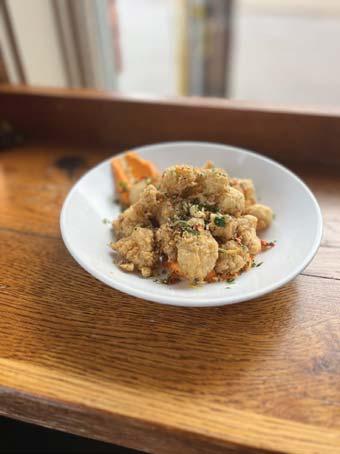
At Gabriela Filipina Kantina, the food is entirely Filipino, which means it’s also a little Spanish. That’s because the Philippines was a Spanish colony for more than 300 years. According to Yanga, Gabriela recognizes the Spanish influence on Filipino food and culture while also celebrating the Philippines’ resistance to Spanish colonization.
For the latter, look no further than the restaurant’s name. Gabriela is named for Gabriela Silang, a female revolutionary who was executed in 1763 for leading a resistance movement against Spanish occupation. By paying homage to Silang, Gabriela honors not only said movement, but Filipina wom-


For instance, Gabriela’s lechon, which is Spanish for “roasted suckling pig,” is popular in the Philippines, but versions exist in Spain and many of its former colonies. This version features moist chunks of fatty pork made even more delicious when dipped in the zesty sawsawan sauce, an onion-flecked blend of soy sauce and vinegar.
Yanga was born in the Philippines but moved to the U.S. with her family as a child, eventually settling in the Columbus area, where she started experimenting with Filipino brunches, which regularly brought lines out the door.
She decided to bring her vibrant, festive take on Filipino food down to Cincinnati because many of her Columbus customers drove up from this area. Her experience, like Wirtjes’s, shows that people are willing to travel for good Filipino food. Luckily, here in the tri-state, we no longer have to travel very far.

The Winery at Versailles
Seven Mile Winery



Cote Winery

info@cotewinery.com
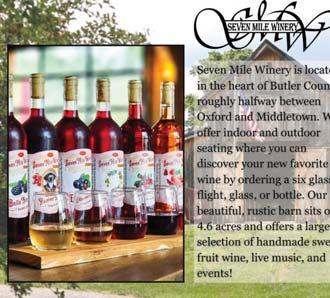
https://cotewinery.com
Heineman’s Winery


Heineman Winery, now in its 5th generation is Ohio’s oldest familyowned winery. Take a ferry trip to Put-inBay and enjoy a bottle of wine and a cheese plate in our beautiful wine garden. We are also home to Crystal Cave, the world’s largest Celestite geode! Tours daily, earlyMay-end of September. Call the winery for more details.



978 Catawba Avenue
Put-in-Bay, OH 43456 (419) 285-2811
heinemanswinery.com



Vinoklet Winery & Restaurant


Vinoklet Winery is perched atop picturesque rolling hills. A glassedenclosed solarium and spacious gazebo provide a panoramic view of the surrounding vineyards. A unique atmosphere for wedding ceremonies, receptions, rehearsal dinners, family parties, banquets, and corporate events. Please check the website for hours and events.
11069 Colerain Ave.

Cincinnati, OH 45252 (513) 385-9309
vinokletwines.com

’Wich Ones
THE RELAXED ATMOSPHERE AND FRIENDLY STAFF AT RUSK KITCHEN + BAR MAKE sandwiches an event. The menu doesn’t feature a lot of twists, but everything has a thoughtful touch and top ingredients, like housemade pickles or meat from local farms. It’s food you’ll remember the next time friends suggest dinner and drinks.
If you’re a chicken sandwich fan, consider Rusk’s Animal Farm (buttermilk fried chicken breast, applewood bacon, Hatch chile pimento cheese, bibb lettuce, house pickles, and roasted garlic aioli on toasted brioche). The salty batter bursts with flavor and preserves juicy chicken while the vegetables add a fresh snap—bacon makes a worthy crown.

The Fried Grouper Po’ Boy (deep fried grouper, bibb lettuce, tomato, house pickles, and lemon caper aioli) is a lord among fish sandwiches. Flaky, peppery batter delivers a contrasting crunch to the delicate white fish, locking in the moisture to keep each bite soft. While the batter is a little on the salty side, the crisp lettuce and fresh tomato balance it well. The house pickles are nearly as good as the grouper and add just the right cut of vinegar to the mix.
Rusk’s fries live up to the side’s true potential. Golden, crispy, and lightly seasoned with salt and pepper, they don’t go overboard, but you won’t want to share. Order accordingly.
—M.LEIGHHOOD
THE COFOUNDER OF Matunda Juicery has your juicing needs covered.

Where does the name Matunda come from? From the Swahili term “Matunda ya Kwanzaa,” which means “the first harvest of fruits.”
How’s the new juice trailer coming? Our trailer is still in its remodeling stages. So far, it’s been a labor of love. Our [launch] goal is summer 2024.
What’s the idea behind it? The trailer is a 1963 Shasta retro camper we’ve named Jumiya, which in Swahili means “community.” We’re excited to go out to [customers] versus waiting in the store for them.
What’s better: being mobile or having a brick-and-mortar location? I wouldn’t say mobile is better than having a brick and mortar. To us, this is a form of expansion.
What’s your best-selling flavor overall? Our “Diced Pineapple,” inspired by a Rick Ross rap song featuring Drake and Wale. Three artists, three ingredients: pineapple, orange, and mint.
What’s your philosophy when it comes to the juice business? Make it less of just a business and more of a societal necessity. If dozens of fast-food chains can exist just doors apart then so can juice bars. – AIESHA D
Matunda Juicery’s products are available at Pause Cincy (2908 Short Vine St., Corryville). Follow @matundajuiceryco on Instagram for more info.


SPUD LIFE
baked potato on steroids. That’s the easiest way to describe tornado potato fries—a whole potato cut into a spiral, fried to a golden crisp, and slapped on a skewer. This popular South Korean dish is now on the menu at Hawkers Alley, along with a number of other Asian street food items, such as takoyaki (Japanese octopus balls), teriyaki chicken skewers, and crispy enoki mushrooms (ask if they’re available). Formerly Bebo’s Artisan Burgers + Frappes, the eatery reopened this summer after a menu revamp. You can top your spud with your choice of several tangy condiments: spicy salt, spicy mayo and parmesan, Japanese mayo and barbecue sauce, or if you’re feeling fancy, truffles and parmesan. Whichever topping you pick, you’ll thank us tater (get it? Tater?).























SLICE NIGHT 15 MINUTES
10 YEARS OF SLICE NIGHT BENEFITING THE UNIVERSITY OF CINCINNATI CANCER CENTER!

Cincinnati Magazine readers and guests celebrated the 10th annual Slice Night along the Ohio River. More than 1,600 attendees enjoyed “all-you-can-want” pizza from local pizzerias, pasta, and dessert—and supported a great cause—on a beautiful end-of-summer evening at Yeatman’s Cove.





THANK YOU TO OUR SPONSORS: Western & Southern Financial Group, MadTree Brewing, Performance Foodservice, Stubb’s, Frank’s Red Hot, McCormick, Takis, Butterball, Pepcid AC, Rao’s Homemade, Garnish Catering, Chinet, Cure Hydration, Home Chef, and Veroni.




DINING GUIDE
CINCINNATI MAGAZINE’S dining guide is compiled by our editors as a service to our readers. The magazine accepts no advertising or other consideration in exchange for a restaurant listing. The editors may add or delete restaurants based on their judgment. Because of space limitations, all

AMERICAN
BOOMTOWN BISCUITS & WHISKEY
of the guide’s restaurants may not be included. Many restaurants have changing seasonal menus; dishes listed here are examples of the type of cuisine available and may not be on the menu when you visit.
To update listings, e-mail: cmletters@cincinnati magazine.com
KEY: No checks unless specified.
AE American Express, DC Diners Club
DS Discover, MC MasterCard, V Visa
MCC Major credit cards: AE, MC, V
$ = Under $15
$$ = Up to $30
Top 10
$$$ = Up to $49
$$$$ = $50 and up
= Named a Best Restaurant March 2023.
(513) 644-9365, cozyscafeandpub.com. Lunch and dinner Tues–Sat, brunch Sat & Sun. MCC, DS. $$$
EMBERS
Boomtown leans hard into the Gold Rush theme: prospector-style overall aprons on servers, bluegrass tunes humming, and rustic decor details. And the dense grub isn’t for the faint of heart. Arrive with an empty belly, ready for a carbo load. The biscuits are all they’re cracked up to be, and the gravy’s not playing around, either. Sample its biscuits and gravy styles with a gravy flight. Or try The Yukon, an anytime breakfast sandwich, featuring fried chicken on par with the best the city has to offer. By the end of the meal, you’ll feel a little out of place without your own denim getup.
9039 U.S. Route 42, Suite H, Union, (859) 384-5910, boomtownbiscuitsandwhiskey. com. Breakfast, lunch, and dinner Wed–Sat. Breakfast and lunch Sun. MCC. $
BROWN DOG CAFÉ
If you haven’t had a plate of Shawn McCoy’s design set in front of you, it’s about time. Many of the menu’s dishes show his knack for the plate as a palette. A trio of grilled lamb T-bone, sirloin, and prawns in scampi butter is a standout. The eye for detail and contrasts of colors and textures belongs to someone who cares for food.
1000 Summit Place, Blue Ash, (513) 794-1610, browndogcafe.com. Lunch and dinner Mon–Sat, brunch Sat. MCC, DS. $$
COZY’S CAFÉ & PUB
On a visit to England, Jan Collins discovered the “cozy” atmosphere of London restaurants built in historic houses. She brought that warm, comfortable feeling back to the United States in opening Cozy’s. Though the atmosphere in the restaurant is reminiscent of Collins’s London travels, the food remains proudly American. The produce in virtually every dish is fresh, seasonal, and flavorful. The braised short rib stands out with its cheesy grits and haystack onions along with a portion of tender meat. And when it comes down to the classics, from the biscuits that open the meal to the carrot cake at the end, Cozy’s does it right.
6440 Cincinnati Dayton Rd., Liberty Twp.,
CATCH UP
Catch Me If You Can, a multi-cuisine restaurant in the Oakley Kitchen food hall, is moving into the old Casa Figueroa in Pleasant Ridge this fall. The lease for the eatery’s Oakley location—known for casual items like chicken wings and shrimp tacos— expires in December. The additional space offered at the new spot will allow it to expand its menu.
The menu here is built for celebration: poshly priced steak and sushi selections are meant to suit every special occasion. Appetizers are both classic (shrimp cocktail) and Asian-inspired (shrimp tempura); fashionable ingredients are name-checked (micro-greens and truffles); a prominent sushi section (nigiri, sashimi, and rolls) precedes a list of archetypal salads; Kobe beef on sushi rolls sidles up to steaks of prime; non-steak entrées (Chilean sea bass or Dover sole with haricots verts and almondine) make for high-style alternative selections. Talk about a party.
8170 Montgomery Rd., Madeira, (513) 9848090, embersrestaurant.com. Dinner seven days. MCC, DC, DS. $$$$
GREYHOUND TAVERN
Back in the streetcar days, this roughly 100-yearold roadhouse was at the end of the Dixie Highway line, where the cars turned around to head north. The place was called the Dixie Tea Room then, and they served ice cream. The fried chicken came along in the 1930s, and they’re still dishing it up today. Families and regulars alike pile in on Mondays and Tuesdays for the fried chicken special. While the juicy (never greasy) chicken with its lightly seasoned, crisp coating is the star, the side dishes—homemade biscuits, coleslaw, green beans, mashed potatoes, and gravy—will make you ask for seconds. Call ahead no matter what night you choose: There’s bound to be a crowd. Not in the mood for chicken? Choose from steaks, seafood, sandwiches, and comfort food options that include meatloaf and a Kentucky Hot Brown. Or just try the onion rings. You’ll wonder where onions that big come from.
2500 Dixie Highway, Ft. Mitchell, (859) 3313767, greyhoundtavern.com. Lunch and dinner seven days, brunch Sun. MCC, DS. $$
GOOSE & ELDER
The third restaurant from chef Jose Salazar, Goose & Elder is a more everyday kind of joint compared to his others. The prices are lower, and most of the dishes, from burgers to grits, are familiar. Salazar’s menus have always hinted that the chef
had a fondness for, well, junk food. But junk food is only junk if it is made thoughtlessly. Goose & Elder has pivoted toward breakfast and brunch fare recently, but everything here is still made with little twists, like the fried bologna sandwich with Dijonnaise and pickles. Even the fries, crinkle cut and served with “goose sauce,” a mildly spiced mayonnaise, are wonderfully addictive. The restaurant demonstrates that what we now consider “fast food” can be awfully good if someone makes it the old-fashioned, slow way.
1800 Race St., Over-the-Rhine, (513) 5798400, gooseandelder.com. Breakfast and lunch Mon & Wed–Fri, dinner Mon & Wed–Sun, brunch Sat & Sun. MCC. $$
OTTO’S
Chef/owner Paul Weckman opened Otto’s, named after his father-in-law, with $300 worth of food and one employee—himself. Weckman’s food is soothing, satisfying, and occasionally, too much of a good thing. His tomato pie is beloved by lunch customers: Vine-ripe tomatoes, fresh basil, and chopped green onions packed into a homemade pie shell, topped with a cheddar cheese spread, and baked until bubbly. Weckman’s straightforward preparations are best. This is, at its heart, a neighborhood restaurant, a place with its own large, quirky family.
521 Main St., Covington, (859) 491-6678, ottosonmain.com. Lunch and dinner Tues–Fri, brunch and dinner Sat–Mon. MCC. $$
QUATMAN CAFÉ
The quintessential neighborhood dive, Quatman’s sits in the shadow of the Our Lady of the Holy Spirit Center, serving up a classic bar burger. Look elsewhere if you like your burger with exotic toppings: This half-pound of grilled beef is served with lettuce, tomato, onion, and pickle. Sometimes cheese. The no-frills theme is straightforward and appealing. A menu of standard sandwich fare and smooth mock turtle soup; beer on tap or soda in cans (no wine or liquor); and checkered tablecloths, serving baskets, and plenty of kitsch is served daily. Peppered with regulars, families, and political discussions, Quatman’s is far from fancy. But it is fun, fast, and delicious.
2434 Quatman Ave., Norwood, (513) 731-4370, quatmancafe.com. Lunch and dinner Mon–Sat. MC, V, DS, MCC. $
RED FEATHER KITCHEN
Historically peasant-grade cuts of meat get the full Pygmalion treatment at Red Feather in Oakley, where there’s deep respect for the time and tending necessary to bring a short rib, pork chop, or steak to its full potential. After a quick sear to lock in juices, the steak takes a turn in the wood-fired oven. While primal cuts play a leading role, the supporting cast is just as captivating. The asparagus soup is especially pleasant on a spring evening and the crispy skin on the salmon acts as the foil to the plump, rich flesh. Service here only improves the experience.
3200 Madison Rd., Oakley, (513) 407-3631, redfeatherkitchen.com. Dinner Wed–Sat, brunch Sun. MCC. $$$
SOUL SECRETS
You no longer need an event to celebrate with a fish fry. At Candice Holloway’s restaurant, Soul Secrets, fried chicken and fish are always on the menu. Servers wearing T-shirts that read “my ancestors sent me” introduce guests to a trim menu full of the best soul food. You can’t go wrong with the fried fish platters. The whiting is good, but the catfish is divine. The cornmeal breading is so perfectly seasoned you won’t need salt, and the light crunch it adds doesn’t hide the star of the show. So soft it’s nearly fluff y, the catfish melts in your mouth. Each catfish platter delivers two enormous pieces of fish along with two sides and a cornbread muffin that may be the best in Cincinnati. This is the kind of meal you take home with you—not just in your heart but in a box—because chances are low you’ll conquer all the fish and sides in one go.
1434 Vine St., Over-the-Rhine, (513) 721-7685, soulsecretscincy.com. Lunch and dinner Tues–Sat. MCC. $

SUGAR N’ SPICE

This Paddock Hills diner, with other locations in Overthe-Rhine and Blue Ash, has been dishing up wispy-thin pancakes and football-sized omelettes to Cincinnatians since FDR was signing new deals. Breakfast and lunch offerings mix old-hat classics like steak and eggs, corned beef hash, and basic burgers with funky iterations that draw on ethnic ingredients such as chorizo and tzatziki. Get here early if you don’t want to stand in line.
4381 Reading Rd., Paddock Hills, (513) 242-3521; 1203 Sycamore St., Over-the-Rhine, (513) 762-0390; 10275 Summit Pkwy., Blue Ash, (513) 447-6453, eatsugarnspice.com. Breakfast and lunch seven days.
MCC. $
TANO BISTRO
This Loveland bistro is comfortable, with reasonably priced food and amenable service. The menu is tidy—25 or so dishes divided between appetizers, salads, and entrées, plus two or three specials—its flavor profile partially influenced by a childhood growing up in a thirdgeneration Italian family. Most of Tano Bistro’s main courses lean toward the comfortable side of American. For instance, Williams serves a stuffed salmon and an allegiance pork chop. The sprout & snout appetizer is also worth a trip to Loveland, combining balsamic-drizzled Brussels sprouts with sliced pork belly.
204 W. Loveland Ave., Loveland, (513) 683-8266; 150 Riverfront Plaza, Hamilton, (513) 795-8654, foodbytano.com. Lunch and dinner Tues–Sat, dinner Sun & Mon. MCC. $$$
TRIO
Trio is nothing if not a crowd-pleaser. Whether you’re in the mood for a California-style pizza or filet mignon (with roasted red potatoes, sauteed spinach, crispy onions, and a red wine demi-glace), the menu is broad enough to offer something for everyone. It may lack a cohesive point of view, but with the number of regulars who come in seven nights a week, variety is Trio’s ace in the hole. A simple Margherita pizza with Roma tomatoes, basil, Parmesan, and mozzarella delivered a fine balance of crunchy crust, soft cheese, and sweet, roasted tomatoes. Paired with a glass of pinot noir, it made a perfect light meal. The service is friendly enough for a casual neighborhood joint but comes
with white tablecloth attentiveness and knowledge. Combine that with the consistency in the kitchen, and Trio is a safe bet.
7565 Kenwood Rd., Kenwood, (513) 984-1905, triobistro.com. Lunch and dinner seven days. MCC, DC. $$
YORK STREET CAFÉ
Five blocks from the Newport riverfront, Terry and Betsy Cunningham have created the sort of comfortable, welcoming environment that encourages steady customers. A dependable menu and quirky atmosphere appeal to a broad range of diners, from non-adventurous visiting relatives to non-attentive children. Desserts have always been one of the stars: flourless chocolate hazelnut torte, bittersweet, rich, and moist; butter rum pudding that would be equally at home on a picnic table or a finely dressed Michelin-starred table.
738 York St., Newport, (859) 261-9675, yorkstreetrestaurant.com. Dinner Tues–Sat, brunch Sun. MCC, DS. $$
BARBECUE
ELI’S BBQ
Elias Leisring started building his pulled pork reputation under canopies at Findlay Market and Fountain Square in 2011. Leisring’s proper little ’cue shack along the river serves up ribs that are speaking-in-tongues good, some of the zazziest jalapeño cheese grits north of the Mason-Dixon line, and browned mashed potatoes that would make any short-order cook diner-proud. The small no-frills restaurant—packed cheek-by-jowl most nights—feels like it’s been there a lifetime, with customers dropping vinyl on the turntable, dogs romping in the side yard, and picnic tables crowded with diners. The hooch is bring-your-own, and the barbecue is bona fide. 3313 Riverside Dr., East End, (513) 533-1957; 133 West Elder St., Over-the-Rhine, (513) 533-1957, ext. 2, elisbarbeque.com. Lunch and dinner seven days. MCC. $
WALT’S HITCHING POST
A Northern Kentucky institution returns. Roughly 750 pounds of ribs per week are pit-fired in a small building in front of the restaurant, with a smaller dedicated smoker out back for brisket and chicken. Walt’s ribs begin with several hours in the smokehouse and then are quick-seared at the time of service. This hybrid method takes advantage of the leaner nature of the baby-back ribs they prefer to use. Each rib had a just-right tooth to it where soft flesh peeled away from the bone. One hidden treasure: Walt’s homemade tomato and garlic dressing. Slightly thicker than a vinaigrette yet unwilling to overwhelm a plate of greens, the two key elements play well together.
3300 Madison Pke., Ft. Wright, (859) 360-2222, waltshitchingpost.com. Dinner seven days. MCC. $$

CAJUN/ CARIBBEAN
BREWRIVER CREOLE
More than 800 miles from New Orleans, this may be as close as you can get to the real deal here in your own backyard. The menu fully leans into Chef Michael Shields’s penchant for cuisine from the Crescent City. His six years of training under NOLA’s own Emeril Lagasse comes through in a scratch kitchen menu that spans a range of the city’s classics. The enormous shrimp and oyster po’boys—the former protein fried in a light and crispy beer batter and the latter in a hearty cornmeal breading—are served on fluff y French bread loaves and dressed with lightly spicy rémoulades. The jambalaya packs all the heat of a late summer day in the French Quarter without masking a hint of its satisfying flavors. Paired with a Sazerac and nightly live jazz, you may just feel tempted to start a second line.
4632 Eastern Ave., Linwood, (513) 861-2484, brewrivercreolekitchen.com. Dinner Tues–Sun, brunch and lunch Sat & Sun. MCC. $
SWAMPWATER GRILL
At first blush, this place is a dive where homesick Cajuns can find a good pile of jambalaya. But thoughtful details like draft Abita Root Beer and char-grilled Gulf Coast oysters on the half shell signal its ambition. Bayou standards like jambalaya, gumbo, and fried seafood also make an appearance. But the extensive menu also features amped-up pub-style items for those who may be squeamish about crawfish tails (which can be added to just about anything on the menu). You’ll also find a roundup of oyster, shrimp, catfish, and alligator po’boys, as well as a selection of hardwood-smoked meats.
3742 Kellogg Ave., East End, (513) 834-7067, swampwatergrill.com. Lunch and dinner Wed–Sun, brunch Sat & Sun. MCC, DS. $$
KNOTTY PINE ON THE BAYOU
The Pine serves some of the best Louisiana home-style food you’ll find this far north of New Orleans. Taste the fried catfish filets with their peppery crust, or the garlic sauteed shrimp with smoky greens on the side, and you’ll understand why it’s called soul food. Between March and June, it’s crawfish season. Get them boiled and heaped high on a platter or in a superb crawfish etouffee. But the rockin’ gumbo—a thick, murky brew of andouille sausage, chicken, and vegetables—serves the best roundhouse punch all year round. As soon as you inhale the bouquet and take that first bite, you realize why Cajun-style food is considered a high art form and a serious pleasure. And you’ll start planning your return trip.
6302 Licking Pke., Cold Spring, (859) 781-2200, theknottypineonthebayou.com. Dinner Tues–Sun. MCC, DS. $$
CHINESE
AMERASIA
A sense of energetic fun defines this tiny Chinese spot with a robust beer list. The glossy paper menu depicts Master Chef Rich Chu as a “Kung Food” master fighting the evil fast-food villain with dishes like “fly rice,” “Brocco-Lee,” and “Big Bird’s Nest.” Freshness rules. Potstickers, dumplings, and wontons are hand shaped. The Dragon’s Breath wontons will invade your dreams. Seasoned ground pork, onion, and cilantro meatballs are wrapped in egg dough, wok simmered, and topped with thick, spicy red pepper sauce and fresh cilantro. Noodles are clearly Chef Chu’s specialty, with zonxon (a tangle of thin noodles, finely chopped pork, and mushrooms cloaked in spicy dark sauce and crowned with peanuts and cilantro) and Matt Chu’s Special (shaved rice noodles, fried chicken, and seasonal vegetables in gingery white sauce) topping the menu’s flavor charts.
521 Madison Ave., Covington, (859) 261-6121, kungfood. online. Lunch Mon–Fri, dinner Sat. MCC. $
GREAT TANG
Although the (24-page!) menu features classic dishes in every style, the specialty at Great Tang is the refined coastal cuisine of Zhejiang. If you like spice, you can get still the Sichuanese and Hunanese classics. One dish will hint at the surprises in store for people who are mainly used to Chinese takeout: the lovely Xian cold noodle. The dish is exquisitely layered: the creamy and nutty undertone of sesame paste, mixed with notes of tang and spice, topped with the bright pop of cilantro. The combination of textures is also delightful, with crunches of cucumber and sprouted mung and the softness of the flat noodles. And that tofu! It was wonderfully meaty, with dense layers, substantial and satisfying as a counterpar t to the noodles. Be as brave as you are in the mood to be. Ask for some suggestions and prepare to be astonished.
7340 Kingsgate Way, West Chester, (513) 847-6097, greattangohio.com. Lunch and dinner Wed–Mon, dim sum Sat & Sun. MCC, DS. $$
ORIENTAL WOK
When Mike and Helen Wong opened Oriental Wok in 1977, the couple wanted to recreate the glamor and refinement
of the Hong Kong-Cantonese cuisine they knew. Today, locals and expats alike enjoy authentic Chinese and ChineseAmerican dishes in dining rooms reminiscent of Beijing. Beyond the elephant tusk entryway and fish ponds and fountains is the warmth and hospitality of the Wong family, service on par with the finest establishments, and very, very good food. Best are the fresh fish: salmon, grouper and sea bass steamed, grilled or fried in a wok, needing little more than the ginger-green onion sauce that accompanies them. Oriental Wok is the tri-state’s longest-running familyowned Chinese restaurant for a reason.
317 Buttermilk Pke., Ft. Mitchell, (859) 331-3000; 2444 Madison Rd., Hyde Park, (513) 871-6888, orientalwok. com. Lunch Mon–Fri (Ft. Mitchell; buffet Sun 11–2:30), lunch Tues–Sat (Hyde Park), dinner Mon–Sat (Ft. Mitchell) dinner Tues–Sun (Hyde Park). MCC. $$
THE PACIFIC KITCHEN
The monster of a menu can be dizzying. Ease in with some top-notch Korean Wings. These slightly bubbly, shattercrisp wings are painted with a thin gochujang chili sauce (a foil to the fat). It takes 24 hours to prep the Cantonese duck, between a honey-vinegar brine to dry the skin, a marinade of star anise, bean paste, and soy within the re-sealed cavity, and the crispy convection oven finish. Dolsot bibimbap had plenty of crispy rice at the bottom of the stone bowl, and the accompanying banchan were soothing yet flavorful. Even dishes like a Malaysian goat stew resonated with rich, original flavors.
8300 Market Place Lane, Montgomery, (513) 898-1833, thepacific.kitchen. Lunch and dinner Mon & Wed–Sun, dim sum lunch Sat & Sun. MCC. $$
ECLECTIC
ABIGAIL STREET
feta, green onion, and mozzarella). There are also six different dipping sauces to choose from, but you need not stray from the house chimichurri.
1342 Walnut St., Over-the-Rhine, (513) 345-8838, checincinnati.com. Lunch Tues–Sun, dinner seven days, brunch Sat & Sun. MCC, DC. $$
THE LITTLEFIELD
Inside a modest 1,500 square-foot space on Spring Grove, just south of Hamilton Avenue, at least 70-odd bourbons behind the bar drive this little restaurant’s philosophy. The menu is meant to be limited, the better to support and celebrate the bottled flavors upfront. There are surprises: the crispy onions served atop the fried Brussels sprouts; skewered golf balls of mild, peppery ground lamb get a faint crust from the final sear. You’ll also want to order the Lebanese chicken katsu—panko-crusted cutlets of chicken, served with spicy curry yogurt-dressed slaw, Lebanese pickles, and black garlic molasses.
3934 Spring Grove Ave., Northside, (513) 386-7570, littlefieldns.com. Lunch Tues–Fri, dinner Tues–Sun, brunch Sat & Sun.. V, MC. $
NICHOLSON’S
To remind local diners that they were here before those young dog-toting punks with their exposed brick and crafty ales in Over-the-Rhine, Nicholson’s branded themselves Cincinnati’s “first and finest gastropub,” and revamped the menu to include plenty of snacks and small plates for grazing, and not-quite-brawny, straightforward sandwiches and main dishes. Try the Faroe Island salmon, a bowl of cock-a-leekie soup, or check out the shepherd’s or Scottish BBQ style burgers or the turkey reuben with Russian dressing. And the bar’s clubby intimacy makes it easy to belly up and enjoy their impressive collection of single malts or a Scottish ale.
625 Walnut St., downtown, (513) 564-9111, nicholsonspub.com. Lunch and dinner seven days. MCC. $$
Most people who’ve eaten at Abigail Street have favorite dishes that they order every visit: the Moroccan spiced broccoli, for example, or the mussels charmoula, with its perfect balance of saffron, creaminess, and tomatoey acidity. Many of the new items on the menu have the same perfected feeling as these classics. Working within a loose framework of Middle Eastern and North African flavors, Abigail Street has never fallen into a routine that would sap its energy. Offerings like the wood-grilled lamb, with apricot, harissa, and pickled Persian cucumbers, feel just as accomplished as old favorites like the falafel, beautifully moist and crumbly with a bright parsley interior. The restaurant is always watching for what works and what will truly satisfy, ready to sacrifice the superficially interesting in favor of the essential.
Top 10
1214 Vine St., Over-the-Rhine, (513) 421-4040, abigailstreet.com. Dinner Tues–Sat. MCC, DS. $$
Top 10 BOUQUET RESTAURANT
Normally diners aren’t pleased when a restaurant runs out of something. At Bouquet, though, surprise changes to the menu are simply a sign of integrity. Chef-owner Stephen Williams is serious about using seasonal ingredients, and if the figs have run out or there is no more chicken from a local farm, so be it. The flavors at Bouquet are about doing justice to what’s available. Preparations are unfussy, complexity coming from within the vegetables and proteins themselves. A spring salad—wonderfully fresh and vibrant, so you know the strawberries included have just come off a nearby vine—is dressed with candy-striped beets, jerk-seasoned pepitas and whipped goat cheese. This determination to make something delicious out of what’s on hand, to embrace limitations, gives the food at Bouquet a rustic, soulful quality.
519 Main St., Covington, (859) 491-7777, bouquetbistro. com. Dinner Tues–Sat. MCC, DS. $$
CHÉ
This Walnut Street spot draws on authentic Argentine recipes, including the empanadas. Choose from a dozen different crispy, perfectly cinched dough pockets, with fillings ranging from traditional (a mixture of cumin-spiced beef, hard-boiled egg, and olives) to experimental (mushrooms,
NOLIA
Chef/Owner Jeffery Harris, a New Orleans native, prepares the cuisine of his beloved city with sophistication and flair, drawing on all the influences that have contributed to the cuisine of the Big Easy—from West African to French to Japanese to Haitian. The menu changes seasonally, with almost a complete overhaul each time. If classic New Orleans dishes do show up on the menu, they’re likely to get delightfully unexpected touches. Take the duck and oyster gumbo. Harris deconstructs the typical stew, building on a base of popcorn rice, instead of the more typical long grain, and a decadent duck fat roux. It’s exquisitely prepared food served in a funky, laid-back atmosphere.
1405 Clay St., Over-the-Rhine, (513) 384-3597, noliakitchen.com. Dinner Tues–Sat. MCC. $$
PAMPAS
Much like American food, Argentine cuisine is a melting pot shaped by immigration, particularly from Italy and Germany, and with plenty of meat on the plate. You see that mix in the menu, but Pampas puts parrillada, the Argentine method of cooking over an open flame, front and center. The chimichurri appears throughout the menu and does wonders wherever it goes. Spicy, tart, and filled with the flavor of oregano, it wakes up the marinated skirt steak. Magnificent desserts deserve special mention. The dolce de leche crème brûlée, with its caramelized sugar crust and shaved chocolate, is particularly popular.
2038 Madison Rd., O’Bryonville, (513) 321-0863, pampascincinnati.com. Brunch Sun, dinner Tues–Sun. MCC, DS. $$
THE QUARTER BISTRO
Quarter Bistro has multiple personalities: one part clubby neighborhood joint, one part dinner and a movie with a dash of lusty romance. The Bistro Burger, a half-pound of black Angus beef, is seasoned but not overly so, with a sturdy-but-not-too-chewy bun. The 18-hour short ribs are the star, and reason enough to skip the movie next door. Braised into a flavor bomb of meat candy, it’s served with papardelle pasta, roasted vegetables, and onion straws. With the no-lip service, The Quarter Bistro could be well on the way to making middle age look sexy.
6904 Wooster Pke., Mariemont, (513) 271-5400, qbcincy.com. Dinner Tues–Sun. MCC, DS. $$
RUTH’S PARKSIDE CAFÉ
The spiritual successor of Mullane’s Parkside Café, Ruth’s brings back the vegetable-forward menu with a few concessions to contemporary tastes. Dinner options now include steaks and heavier entrées. But the stir-fries, beans and rice, pasta, and the traditional option to add a protein to an entrée (tofu, tempeh, chicken, or local chorizo) for an upcharge are all old standards. While dishes are generally hearty, they are rarely too rich, leaving room to freely consider dessert. There is a small selection of baked goods, including a gooey butter cake, homemade fruit pies, and Madisono’s Gelato.
1550 Blue Rock St., Northside, (513) 542-7884, ruthscafe.com. Lunch Mon–Fri, dinner Mon–Sat. MCC. $$

THE STANDARD
Owners Paul Weckman and Emily Wolff offer a pared-down menu of small plates and sandwiches. It’s simple but satisfying, with a small-town diner vibe. After a complete menu overhaul that shifted the restaurant away from its Pan-Asian street food concept, The Standard focuses on Americana classics, like smoked brisket chopped cheese, smash burgers, smoked wings, and chili.
434 Main St., Covington, (859) 360-0731, facebook.com/thestandardcov. Dinner Tues–Sun. MCC. $
20 BRIX
This restaurant mixes Mediterranean influences with homespun choices, and he comes up with some marvelous food. Lamb meatballs with
melted onions and romesco sauce are sweet and peppery, and their simplicity partners well with a lush Zinfandel. The excellent wine list, arranged by flavor profiles within the varietals, features dozens of varieties by the glass in five-ounce or twoounce pours, which makes it easy to try several.
101 Main St., Milford, (513) 831-2749, 20brix. com. Lunch and dinner Mon–Sat. MCC, DS, DC. $$



FRENCH
CHEZ RENÉE FRENCH BISTROT
Based on American stereotypes of French food— that it’s elaborate, elitist, and expensive—one might expect Chez Renée to fall on the chichi side. Instead, it’s elegant in an everyday way, operating on the principle that it is better to excel at simplicity than to badly execute something complicated. The formula is not complex: Simple ingredients, generally fresh and from nearby, prepared without much fuss. Warmed brie is served with thyme, almonds, fruit, and bread, and the chicken risotto is served with creamy mushrooms. This is solid, tasty food, both approachable and well-executed. It’s well on its way to becoming, as a good bistrot should be, a neighborhood institution.



233 Main St., Milford, (513) 428-0454, chezreneefrenchbistrot.com. Lunch Fri & Sat, dinner Wed–Sat. MCC. $$
FRENCH CRUST
Located in the old Globe Furniture building at the corner of Elm and Elder Streets, this Jean-Robert de Cavel creation offers French fare in the heart of Over-the-Rhine. Swing by for lunch and have a
quiche Lorraine (French Crust’s quiches are unrivaled in our humble opinion) and an avocado and shrimp salad, or opt for a more hearty entree— like cassoulet—for dinner. If you’re an early bird, a Croque Monsieur (with a sunny side-up egg) is a great way to start the day.
1801 Elm St., Over-the-Rhine, (513) 455-3720, frenchcrustcafe.com. Breakfast and lunch Wed–Sun, dinner Thurs–Sat. MCC. $$


Top10 LE BAR A BOEUF
If it’s been a couple of years since you’ve been to Le Bar a Boeuf—the late JeanRobert de Cavel’s fun-yet-refined French bistro located on the first floor of the Edgecliff Private Residences in East Walnut Hills—it may be time for a revisit. The formerly burger-centric menu now approaches the full repertoire of bistro classics. The menu reads like a greatest hits list of bistro fare, with escargot, beef tartare, duck leg confit, steak frites, and French onion soup all making appearances. As France’s influence on American fine dining has waned, it’s refreshing to see a restaurant committed to not only preserving the French classics but reinvigorating them.
2200 Victory Pkwy., East Walnut Hills, (513) 7512333, lebarboeuf.com. Dinner Wed–Sat. MCC. $$
INDIAN
AMMA’S KITCHEN
Muthu Kumar Muthiah serves traditional southern Indian and Indo-Chinese vegetarian cuisine, but with a sizable Orthodox Jewish community nearby, Muthiah saw an opportunity: If he was going to cook vegetarian, why not also make it
And pumpkin pie.

BREW REDO
Braxton Brewing recently reopened its Pendleton location as The Point after a six-week renovation. Part taproom, part private event space, it features an audiovisual system and a TV wall and can accommodate up to 100 guests. braxton brewing.com

kosher? Muthiah prepares every item—from the addictively crunchy gobhi Manchurian, a spicy Chinese cauliflower dish, to the lemon pickle, tamarind, and mint sauces—entirely from scratch under the careful eye of Rabbi Michoel Stern. Always 80 percent vegan, the daily lunch buffet is 100 percent animal-product-free on Wednesdays. Tuck into a warm and savory channa masala (spiced chickpeas) or malai kofta (vegetable dumplings in tomato sauce) from the curry menu. Or tear into a crispy, two-foot diameter dosa (chickpea flour crepe) stuffed with spiced onions and potatoes.
7633 Reading Rd., Roselawn, (513) 821-2021, cincinnati. ammaskitchen.com. Lunch buffet Mon–Fri (all vegan on Wed), dinner seven days. MC, V, DS. $
BRIJ MOHAN
Order at the counter the way you might at a fast food joint, except the shakes come in mango and there’s no supersizing your mint lassi. The saag, full of cream in most northern Indian restaurants, is as intensely flavored as collard greens in the Deep South—real Punjabi soul food. Tarka dal is spectacular here, the black lentils smoky from charred tomatoes and onions, and the pani puri, hollow fried shells into which you spoon a peppery cold broth, burst with tart cool crunch. Follow the spice with soothing ras malai, freshly made cheese simmered in thick almond-flavored milk, cooled and sprinkled with crushed pistachios.
11259 Reading Rd., Sharonville, (513) 769-4549, brijmohancincinnati.com. Lunch Fri–Sun, dinner Tues–Sun. MCC, DC.. $



ITALIAN
A TAVOLA

In 2011, Jared Wayne opened A Tavola Pizza with two friends just as OTR was blowing up. A Ferrara pizza oven was ordered from Italy; Wayne, a skilled woodworker, built custom
tables; and the menu was fleshed in with trendy crowdpleasers like charcuterie and craft cocktails. Fast-forward a decade. The OTR outpost is closed but the second location is still going strong in the ’burbs: A Tavola Madeira capitalizes on the menu from the Vine Street location, including the fresh and zesty artichoke pizza on a Neapolitan crust; gooey mozzarella-filled arancini, or risotto fritters; and the zucchini mozzarella. Wash down your small plates with a glass of crisp and grassy Sannio falanghina or an ice-cold Rhinegeist. They’re definitely going to need a bigger parking lot.
7022 Miami Ave., Madeira, (513) 272-0192, atavolapizza. com. Lunch and dinner seven days. MCC, DC. $


ADRIATICO’S
Everything about this place says it’s about the pizza: the herbed sauce, the assault of the cheese, the toppings. It’s all evenly distributed, so you get a taste in every bite. Adriatico’s still delivers the tastiest pizza in Clifton. On any given night the aroma wafts through every dorm on campus. It’s that popular because it’s that good. Being inexpensive doesn’t hurt either.
113 W. McMillan St., Clifton Heights, (513) 281-4344, adriaticosuc.com. Lunch and dinner seven days. MCC. $
NICOLA’S

you try something new, too.
1420 Sycamore St., Pendleton, (513) 721-6200, nicolasotr.com. Dinner Mon–Sat. MCC, DC, DS. $$$




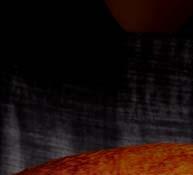

PEPP & DOLORES

As with all of Thunderdome’s restaurants, you get a sense that they want to deliver a meal that satisfies many different kinds of people. The prices are reasonable, with pasta entrées about $15. The dishes are familiar in their flavors, but everything feels balanced, modulated and gradually perfected. There is lovely variety: the limone pasta is zippy with lemon and chili flakes, and just the right mixture of tart and creamy; the deep meaty flavors on the mushroom toast are balanced with a nice acidity; and the heat in dishes like the eggplant involtini is just enough to wake up the sauce without overwhelming the flavor. The menu has a wealth of excellent vegetarian and pasta-alternative options.
1501 Vine St., Over-the-Rhine, (513) 419-1820, peppanddolores.com. Lunch Fri–Sun, dinner seven days. MCC. $$
PRIMAVISTA







Top 10
Chef/Restaurateur Cristian Pietoso carries on the legacy of his father, Nicola, as the elder Pietoso’s Over-the-Rhine eatery celebrated 25 years in business in 2021. You can still get the old Italian classics, and they’ll be as good as ever, but the rest of the menu has blossomed into a freewheeling tour of modern American cuisine. Any establishment paying this level of attention to detail— from the candied slice of blood orange on the mascarpone cheesecake to the staff’s wine knowledge—is going to put out special meals. Rarely have humble insalate been so intricately delicious, between the perfectly nested ribbons of beets in the pickled beet salad or the balance of bitterness, funkiness, and creaminess in the endive and Gorgonzola salad. Order an old favorite, by all means, but make sure
Besides offering the old-world flavors of Italy, Primavista also serves up a specialty no other restaurant can match: a bird’s eye view of Cincinnati from the west side. The kitchen is equally comfortable with northern and southern regional specialties: a Venetian carpaccio of paper-thin raw beef sparked by fruity olive oil; house-made fresh mozzarella stuffed with pesto and mushrooms; or artichoke hearts with snails and mushrooms in a creamy Gorgonzola sauce from Lombardy. Among the classics, nothing is more restorative than the pasta e fagioli, a hearty soup of cannellini, ditali pasta, and bacon. Most of the pastas are cooked just a degree more mellow than al dente so that they soak up the fragrant tomato basil or satiny cream sauces. The forktender osso buco Milanese, with its marrow-filled center bone and salty-sweet brown sauce (marinara and lemon juice), is simply superb. Desserts present further problems; you’ll be hard-pressed to decide between the house-made
as the rest of the menu. Sometimes it pays to dine alone. 595 Race St., downtown, (513) 246-0150, barusushi. com. Dinner Tues–Sat. MCC. $$$
tiramisu or bread pudding with caramel sauce, marsalasoaked raisins, and cream.
810 Matson Pl., Price Hill, (513) 251-6467, pvista.com. Dinner Wed–Sun. MCC, DC, DS. $$
SOTTO
There are certain books and movies that you can read or watch over and over. Eating at Sotto is a similar experience: familiar, but so profound and satisfying that there is no reason to ever stop. Unlike other restaurants, where the techniques are often elaborate and unfamiliar, the magic at Sotto happens right in front of you, using ordinary elements and methods. When you taste the results, though, you realize that some mysterious transmutation has taken place. Orecchiette with rapini and pork sausage comes in a buttery, lightly starchy broth with a kick of spice that you could go on eating forever. From the texture of the chicken liver mousse to the seasonal fruit sauce on the panna cotta, most of the food has some added element of soulfulness.
Top 10
118 E. Sixth St., downtown, (513) 977-6886, sottocincinnati.com. Dinner seven days. MCC, DS. $$
VIA VITE
Via Vite serves up crowd-pleasing entrées, including the Pietoso family Bolognese, over penne, right on Fountain Square. (Add in a golf-ball-sized veal meatball heavy with lemon zest, and it’s an over-the-top comforting main dish.) The same applies to the risotto, where a few small touches add sophistication. Carnaroli rice results in a glossier, starchier dish. A puree of asparagus turns the risotto an eye-popping green, and the poached lobster garnish creates a nice back-and-forth between vegetal and briny flavors. Braised lamb shank over polenta is comforting workhorse, and the flavorful Faroe Island salmon with roasted carrot puree, caramelized Brussel sprouts and truffled brown butter balsamic vinaigrette.
520 Vine St., downtown, (513) 721-8483, viaviterestaurant.com. Dinner Mon–Sat. MCC, DS. $$
JAPANESE
ANDO
You don’t go just anywhere to dine on uni sashimi (sea urchin) or tanshio (thinly sliced charcoal-grilled beef tongue). Don’t miss the rich and meaty chyu toro (fatty big-eye tuna), or the pucker-inducing umeshiso maki (pickled plum paste and shiso leaf roll). Noodles are also well represented, with udon, soba, or ramen options available. And don’t forget to ask about the specials; owners Ken and Keiko Ando always have something new, be it grilled koji or marinated amberjack smoked salmon crudo, delicacies that you’ll be hard-pressed to find in any of those Hyde Park pan-Asian wannabes. The only thing you won’t find here is sake, or any other alcohol. Bring your own, or stick to the nutty and outright addicting barley tea.
11255 Reed Hartman Hwy., Blue Ash, (513) 954-0041, andojapaneserestaurant.com. Dinner Tues–Sat. MCC. $$$
BARU
Baru, the sleek izakaya in the former MidiCi space, prioritizes bar dining, which is meant to be enjoyed alongside its eclectic drinks list. The menu is broken down into drinks, sushi, “small plates,” “plates,” sides, and ishiyaki. Start with clever cocktail offerings, like the Japanese Highball (which uses Japanese whiskey), the Sake-tini, or the sweetly spicy Wasabi Margarita. Sushi chef Samson Kim’s offerings are—like the rest of the menu—fun and funky. The sushi menu is varied, but concise, featuring a trio of ahi tuna, spicy tuna, and escolar, as well as a quail egg nigiri. If sushi got the party going, the theatrical ishiyaki kicked it into high gear. The term refers to dishes that diners grill tableside on a hot stone. We went with the Sakura Wagyu, sourced from Ohio’s own Sakura Farms. For all its convivial buzz, Baru is also a spot where solo diners can enjoy a few peaceful barside bites. Tthe Crispy Rice Spicy Tuna from the small plates section brought the same level of freshness and quality
Top 10 KIKI Kiki started as a pop-up at Northside Yacht Club, then leapt into brick-and-mortar life in College Hill. Your best bet here is to share plates, or simply order too much, starting with the edamame, salted or tossed in tare, a savory dipping sauce. Add the karaage fried chicken, with the Jordy mayo and the pepe meshi, confit chicken on spaghetti and rice that somehow works. And, yes, the ramen, too. The shio features pork belly and tea-marinated soft-boiled egg, but the kimchi subs in tofu and its namesake cabbage for the meat.
5932 Hamilton Ave., College Hill, (513) 541-0381, kikicincinnati.com. Lunch Sun and dinner Wed–Sat. MCC. $
KYOTO
Owner Jason Shi seems to know everybody’s name as he chats up diners, guiding them through the extensive sushi and sashimi menu. Five young sushi chefs, all part of Shi’s family, work at light speed behind the bar, a choreography backlit by rows of gleaming liquor bottles. Dinner proceeds with glorious chaos as a feisty Carla Tortelli–like server delivers one dish after another—slivers of giant clam on ice in a super-sized martini glass, a volcanic tower of chopped fatty tuna hidden inside overlapping layers of thin avocado slices, smoky grilled New Zealand mussels drizzled with spicy mayo, and delicate slices of a samurai roll—all between shots of chilled sake.
12082 Montgomery Rd., Symmes Twp., (513) 583-8897, kyotousa.m988.com. Lunch and dinner seven days. MCC. $$
ZUNDO RAMEN & DONBURI
A stark contrast to Styrofoam cup soup, chef Han Lin’s ramens are a deep and exciting branch of cuisine, capable of subtlety, variation, and depth. The simplicity of the dish’s name hides a world of complexity. Zundo uses the traditional Japanese building blocks of flavor—soy sauce, miso, sake, mirin—to create something freewheeling and timetested. Bowls of ramen come with a marinated soft-boiled egg half, roast pork, green onion, and a healthy serving of noodles. Each has a distinct identity, like the milky richness of the tonkotsu, the rich and buttery miso, or the light and faintly sweet shoyu ramen. A transformative add-in is the mayu, or black garlic oil. Dripped on top of one of the subtler broths, it adds a deep, mushroom-y richness, with the hint of burned flavor that makes barbecue so good. 220 W. 12th St., Over-the-Rhine, (513) 975-0706, zundootr.com. Lunch and dinner Tues–Sun. MCC. $$
KOREAN
RIVERSIDE KOREAN RESTAURANT
Come for the jham bong—a seafood soup with flour noodles in a spicy broth with pork, shrimp, squid, mussels, and vegetables. Revered for its medicinal properties, the dinnersized soup will leave your eyes glistening and your brow beaded with sweat. It’s a detox for your overindulgence, rejuvenation for when you’re feeling under the weather. Expect crowds on weekends. Expect too, that dozens of them have come for dolsot bibimbap, the hot stone pots filled with layers of rice, vegetables, meat or tofu, egg, and chili paste. Characterized by its electric color and addictive flavors, Riverside Korean’s version is a captivating bowl of heaven.
512 Madison Ave., Covington, (859) 291-1484, riversidekoreanrestaurant.com. Lunch Tues–Fri, dinner Tues–Sun. MCC, DS. $$
MEDITERRANEAN
ANDY’S MEDITERRANEAN GRILLE
In this lively joint with a burnished summer lodge interior of wood and stone, even the food is unrestrained: rough-
cut chunks of charbroiled beef tenderloin, big slices of onion and green pepper turned sweet and wet in the heat, skewers of marinated and charbroiled chicken perched on rice too generous for its plate. Co-owner Andy Hajjar mans his station at the end of the bar, smoking a hookah pipe that fills the air with the sweet smell of flavored tobacco, while the friendly but hurried staff hustles through.
906 Nassau St., Walnut Hills, (513) 281-9791, andyskabob.com. Lunch Mon–Sat, dinner seven days. MCC. $$
Top 10 PHOENICIAN TAVERNA
No matter how much restraint you go in with, meals at Phoenician Taverna quickly become feasts. There is just too much that’s good, and everything is meant to be shared. With fresh pita bread continuously arriving from the ovens, and a table of quickly multiplying meze (hummus, falafel, muhammara), there is a warmth and depth to the cooking that envelops you. With such traditional cuisine, you may think there isn’t much left to discover beyond simply executed classics prepared according to time-tested methods. But there are always new discoveries as the flavors mingle from plate to plate: the tabbouleh with the hummus, mixed with a touch of harissa, or the smoky baba ghanoush spooned onto falafel. Phoenician Taverna keeps taking these classics a little further.
7944 Mason Montgomery Rd., Mason, (513) 770-0027, phoeniciantaverna.com. Lunch Tues–Fri, dinner Tues–Sun. MCC. $$
SULTAN’S MEDITERRANEAN CUISINE
The meze, a parade of small plates and appetizers—the refreshing yogurt dish with cucumber, mint, and garlic known as cacik, and its thicker cousin haydari, with chopped walnuts, dill, and garlic—is rounded out with flaky cheese or spinach bourekas, falafels, soups, salads, and more, while baked casseroles or stuffed cabbage and eggplant dishes (dubbed “Ottoman specials”) augment the heavy focus on kebabs: chunks of lamb and beef on a vertical spit for the popular Doner kebab (a.k.a. Turkish gyro), peppery ground lamb for the Adana kebab, or cubed and marinated for the Shish kebab.
7305 Tylers Corner Dr., West Chester, (513) 847-1535, sultanscincinnati.com. Lunch and dinner seven days. MCC, DS. $$
MEXICAN MAZUNTE
Mazunte runs a culinary full-court press, switching up specials to keep both regulars and staff engaged. Pork tamales arrive swaddled in a banana leaf, the shredded pork filling steeped in a sauce fiery with guajillo and ancho chilies yet foiled by the calming sweetness of raisins. The fried fish tacos are finished with a citrusy red and white cabbage slaw that complements the accompanying mango-habañero salsa. With this level of authentic yet fast-paced execution, a slightly greasy pozole can be easily forgiven. Don’t miss the Mexican Coke, the margaritas, or the non-alcoholic horchata.
5207 Madison Rd., Madisonville, (513) 785-0000, mazuntetacos.com. Lunch and dinner Mon–Sat, brunch Sun. MCC. $
MESA LOCA
Sitting on a corner of Hyde Park Square, it’s easy to see that Mesa Loca has an absolute dream of a location. The pandemic forced a few changes to the seafood-centric menu, but those dishes still on the menu indicate what Mesa Loca could be. The tuna ceviche is nicely balanced: tart, with a little spicy creaminess, and a good crispy tostada. One of Mesa Loca’s appealing qualities is its dramatic flair: The yucca fries come stacked on the plate like a late-stage game of Jenga, and their sour-and-spicy rub is quite delicious and striking against the bright starchy white of the fries.
2645 Erie Ave., Hyde Park, (513) 321-6372,
THE SHOPPING EVENT OF THE SEASON!
NOV. 9-12


DUKE ENERGY CONVENTION CENTER
NOW OPEN 4 DAYS!
TAKE A BREAK FROM THE EXCITEMENT AT THE WINE DOWN WINE-ANDAPPETIZER LOUNGE LOCATED IN THE CENTER OF THE SHOW FLOOR & ENJOY A GLASS OF WINE OR ARTISAN CHEESE PLATE.
VISIT WITH SANTA & TAKE A FESTIVE PHOTO WITH THE JOLLY FELLOW. DONATIONS WELCOMED FOR BUTLER COUNTY SPECIAL OLYMPICS.

GIRLS NIGHT OUT: CELEBRATE THE SEASON WITH FRIENDS & FAMILY WITH MUSIC & DRINKS ON FRIDAY AND SATURDAY EVENING FROM 4-7 PM SHOP VENDORS YOU WON’T FIND ANYWHERE ELSE!



GRAB YOUR GAL PALS AND STOP BY THE HOLIDAY PHOTO BOOTH, BY A LITTLE BIT OF THIS, TO GET A COMMEMORATIVE PHOTO OF YOUR FESTIVE FUN AT THE SHOW!

mesalocahydepark.com. Lunch and dinner seven days. MCC. $$
SOCO’S
Mexican places seem to change hands in this town so often that you can’t get the same meal twice.
Soco’s (formerly Montoya’s) is the exception. They’ve been hidden in a tiny strip mall off the main drag in Ft. Mitchell for years. It’s unpretentious and seemingly not interested in success, which means success has never gone to their head here. At a place where you can get Huracan Fajitas with steak, chicken, and chorizo or Tilapia Asada, the tacos are still a big item.
2507 Chelsea Dr., Ft. Mitchell, (859) 341-0707. Lunch and dinner Tues–Sat. MC, V, DS. $


TAQUERIA CRUZ
The menu at this four-table mom-and-pop welcomes you to “a little piece of Mexico.” The huaraches (spelled guarachis here), are fl at troughs of thick, handmade fried masa dough the approximate shape and size of a shoeprint, mounded with beans and slivers of grilled beef or chili-red nubs of sausage, shredded lettuce, a crumble of queso fresco, and drizzle of cultured cream. Should you have an adventurous side, you can have your huarache topped with slippery tongue, goat meat, shredded chicken, or pork. There are stews, carne asada plates, and sopes—saucers of fried masa much like huaraches, only smaller.
518 Pike St., Covington, (859) 431-3859. Lunch and dinner seven days. Cash. $

SEAFOOD
MCCORMICK & SCHMICK’S
The daily rotation here reads like a fisherman’s wish list: fresh lobsters from the coast of Maine, ahi tuna from Hawaii, clams from New England. But high-quality ingredients are only half the equation; preparation is the other. Herb-broth sea bass, served with roasted fingerling potatoes, makes the taste buds dance. The spacious digs and attentive waitstaff bring a touch of class to Fountain Square and make it a sophisticated destination. It’s likely to remain a favorite. After all, it’s right in the middle of things.
21 E. Fifth St., downtown, (513) 721-9339, mccormickandschmicks.com. Lunch and dinner seven days. MCC, DC, DS. $$
ROSEWOOD SUSHI, THAI & SEAFOOD
Chanaka De Lanerolle sold Mt. Adams Fish House back in 2011, and Rosewood Sushi, Thai & Seafood is its reincarnation—and reinvention. Most of the menu tends toward fairly conservative takes on classics, like well-seasoned crab cakes and thick, creamy chowder full of seafood. The handful of ethnic experiments on the menu are among its most vibrant offerings, including a Mediterranean fish stew that takes inspiration from the North African coast. Tender, fluffy couscous soaks up a fi ery but sweet tomato sauce that showcases chiles and peppercorns, golden raisins, and lovely firm cashews, and the stew itself is packed with mussels, shrimp, and chunks of fish.
3036 Madison Rd., Oakley, (513) 631-3474,
oakleyfishhouse.com. Lunch Fri–Sun, dinner Tues–Sun. MCC. $$$
STEAKS
JEFF RUBY’S
Filled most nights with local scenesters and power brokers (and those who think they are), everything in this urban steakhouse is generous—from the portions to the expert service. White-jacketed waiters with floor-length aprons deliver two-fisted martinis and mounds of greens dressed in thin vinaigrettes or thick, creamy emulsions. An occasional salmon or sea bass appears, and there’s a small but decent assortment of land fare. But most customers, even the willowy model types, inhale slabs of beef (dry aged USDA prime) like they’re dining in a crack house for carnivores. The best of these is Jeff Ruby’s Cowboy, 22 ounces of 70-day dry-aged bone-in rib eye. This is steak tailor-made for movers and shakers.
505 Vine St., downtown, (513) 784-1200, jeffruby.com. Dinner Mon–Sat. MCC, DC. $$$$
Top10 LOSANTI
A bit more upscale than its sister restaurant, Crown Republic Gastropub, Losanti is also more conservative in its offerings. Service is friendly and informal, and though the meal feels like a special occasion, prices and atmosphere are right for, say, a date, rather than a wedding anniversary. The filet mignon, rib eye, and New York strip are cut to order for each table (there are a few available weights for each). The steaks themselves are totally irreproachable, perfectly seasoned,
GOODBYE AND HELLO
Latonia eatery
Kealoha’s Kitchen is set to move into the former Dee Felice Café soon. The restaurant, which specializes in family recipes from owner Val Abafo’s Hawaiian heritage, is eyeing an opening date in Covington’s MainStrasse sometime this month. kealohaskitchen.com
cooked to precisely the right point. Losanti even makes the steakhouse sides a little special. Sweet and smoky caramelized onions are folded into the mashed potatoes, a nice dusting of truffles wakes up the mac and cheese, and the sweet corn is at least freshly cut off the cob and recalls elote with lime and chile.
1401 Race St., Over-the-Rhine, (513) 246-4213, losantiotr.com. Dinner seven days. MCC. $$$
Top10 THE PRECINCT
Part of the appeal of the Ruby restaurants is their ability to deliver deep, comfort-food satisfaction. And the steaks. The meat is tender with a rich mineral flavor, and the signature seasoning provided a nice crunch, not to mention blazing heat. The supporting cast is strong—the basket of warm Sixteen Bricks bread with a mushroom truffle butter, the addictive baked macaroni and cheese, the creamy garlic mashed potatoes, the crisp-tender asparagus with roasted garlic and lemon vinaigrette—and dinner ends on a sweet note with a piece of Ruby family recipe cheesecake. Neither cloyingly sweet nor overwhelmingly creamy, it’s a lovely slice of restraint.
311 Delta Ave., Columbia-Tusculum, (513) 321-5454, jeffruby.com/precinct. Dinner seven days. MCC.

$$$$
THAI
GREEN PAPAYA
Inside this simple dining room, replete with soothing browns and greens and handsome, dark wood furniture, it takes time to sort through the many curries and chef’s specialties, not to mention the wide variety of sushi on the something-for-everyone menu. Have the staff—friendly, attentive, and knowledgeable—help you. When the food arrives, you’ll need only a deep inhale to know you made
the right choice. The Green Papaya sushi rolls are as delicious as they look, with a manic swirl of spicy mayo and bits of crabstick and crispy tempura batter scattered atop the spicy tuna, mango, cream cheese, and shrimp tempura sushi—all rolled in a vivid green soybean wrap.
2942 Wasson Rd., Oakley, (513) 731-0107, greenpapayacincinnati.com. Lunch Mon–Sat, dinner seven days. MCC. $$
TEAK THAI
Owner Chanaka De Lanerolle has said that he decided to bring back Teak’s take on Thai food because of the renewed vibrancy in Over-the-Rhine, which he compared to the energy he felt in Mt. Adams during his time there. But for all of the hype around the restaurant’s re-emergence on the scene, it’s probably best to consider it a reimagining rather than a reopening. While long-time favorites show up on the menu, prepared by many of the same kitchen staff members from Mt. Adams, some adaptations have been made to better meet expectations of modern diners. Letting go of preconceived notions about Teak will serve you well. With a two-sided, standalone sushi menu and a wide variety of main plates ranging from small bites to signature dishes, you have plenty of room to craft your own dining experience.
1200 Race St., Over-the-Rhine, (513) 421-8325, teakotr. com. Lunch and dinner Tues–Sun. MCC. $$
WILD GINGER
The ability to satisfy a deep desire for Vietnamese and Thai fusion cuisine is evident in Wild Ginger’s signature Hee Ma roll—a fortress of seaweed-wrapped rolls filled with shrimp tempura, asparagus, avocado, and topped with red tuna, pulled crab stick, tempura flakes, a bit of masago, scallions, and of course, spicy mayo. It’s tasty, even though the sweet fried floodwall of tempura and spicy mayo overpowered the tuna completely. The spicy pad char entrée was a solid seven out of 10: broccoli, carrots, cabbage, succulent red bell peppers, green beans, and
beef, accented with basil and lime leaves in a peppercornand-chili brown sauce.
3655 Edwards Rd., Hyde Park, (513) 533-9500, wildgingercincy.com. Lunch and dinner Mon–Sun. MCC, DS. $$


VIETNAMESE
PHO LANG
THANG
This eatery is a greatest hits playlist of Vietnamese cuisine: elegant, brothy pho made from poultry, beef, or vegan stocks poured over rice noodles and adrift with slices of onions, meats, or vegetables (the vegan pho chay is by far the most flavorful); fresh julienned vegetables, crunchy sprouts, and herbs served over vermicelli rice noodles (again, the vegan version, bun chay, is the standout); and bánh mì. Be sure to end with a cup of Vietnamese coffee, a devilish jolt of dark roast and sweetened condensed milk that should make canned energy drinks obsolete.
1828 Race St., Over-the-Rhine, (513) 376-9177, pholangthang.com. Lunch and dinner seven days. MCC, DS, DC. $

CINCINNATI MAGAZINE, (ISSN 0746-8 210), November 2023, Volume 57, Number
2. Published monthly ($19.95 for 12 issues annually) at 1818 Race St., Ste. 301, Cincinnati, OH 45202. (513) 421-4300. Copyright ©

Holy Roller
ST. PETER IN CHAINS CATHEDRAL HAS ENOUGH CATHOLIC ARTIFACTS TO BE A MUSEUM.
One of the most storied pieces in its collection is the fully restored carriage of Archbishop John Purcell. It dates back to a time when German and Irish Catholic immigrants were arriving in Cincinnati in droves, putting their money into Protestant-owned banks. Local Catholics called for a bank of their own, and Archbishop Purcell answered that prayer, allowing his brother (also a priest) to open a bank that found quick success. Purcell’s brother did what most bankers did at the time—he invested the money in real estate. So when a financial panic set in during the 1870s, things turned sour. “Everybody [wanted] their money,” says Rev. Jan Schmidt, director of pastoral vitality at the cathedral. “But most banks don’t keep all the money in the bank. They invest it. And of course, they couldn’t get to it.” The crisis sent Purcell into exile in Brown County, where he lived in the Ursulines of Brown County’s convent for the last three years of his life. Rediscovered in a barn near the convent in the early 1970s, the coach was disassembled, refurbished, and carefully moved into the cathedral as part of the state’s bicentennial celebration.
 —LAUREN FISHER
—LAUREN FISHER
REDISCOVER DOWNTOWN CINCINNATI

Meet Me Downtown is about rediscovering the heart of Cincinnati and reigniting its economic and cultural vibrancy. Whether you're eager to support local businesses, experience a world-class cultural hub, or reconnect with colleagues, mentors, and friends, downtown Cincinnati is the place to be!


To help, we're offering some giveaways, promotions, and ways to stay in the know. learn more and enter to win some prizes at meetmedowntowncincy.com


Learn
 JOIN THE MOVEMENT TODAY
JOIN THE MOVEMENT TODAY
Internships that make an impact
Miami’s Social Justice internship program places students in local organizations like Over-the-Rhine Community Housing (OTRCH).

“The longtime residents of Over-the-Rhine need advocates,” says Allison Sifri ’23, who interned with OTRCH during her senior year.

“OTRCH allows people the opportunity to stay in the neighborhood they’ve always known by providing affordable housing.”
public schools for internships
THE PRINCETON REVIEW, 2023











